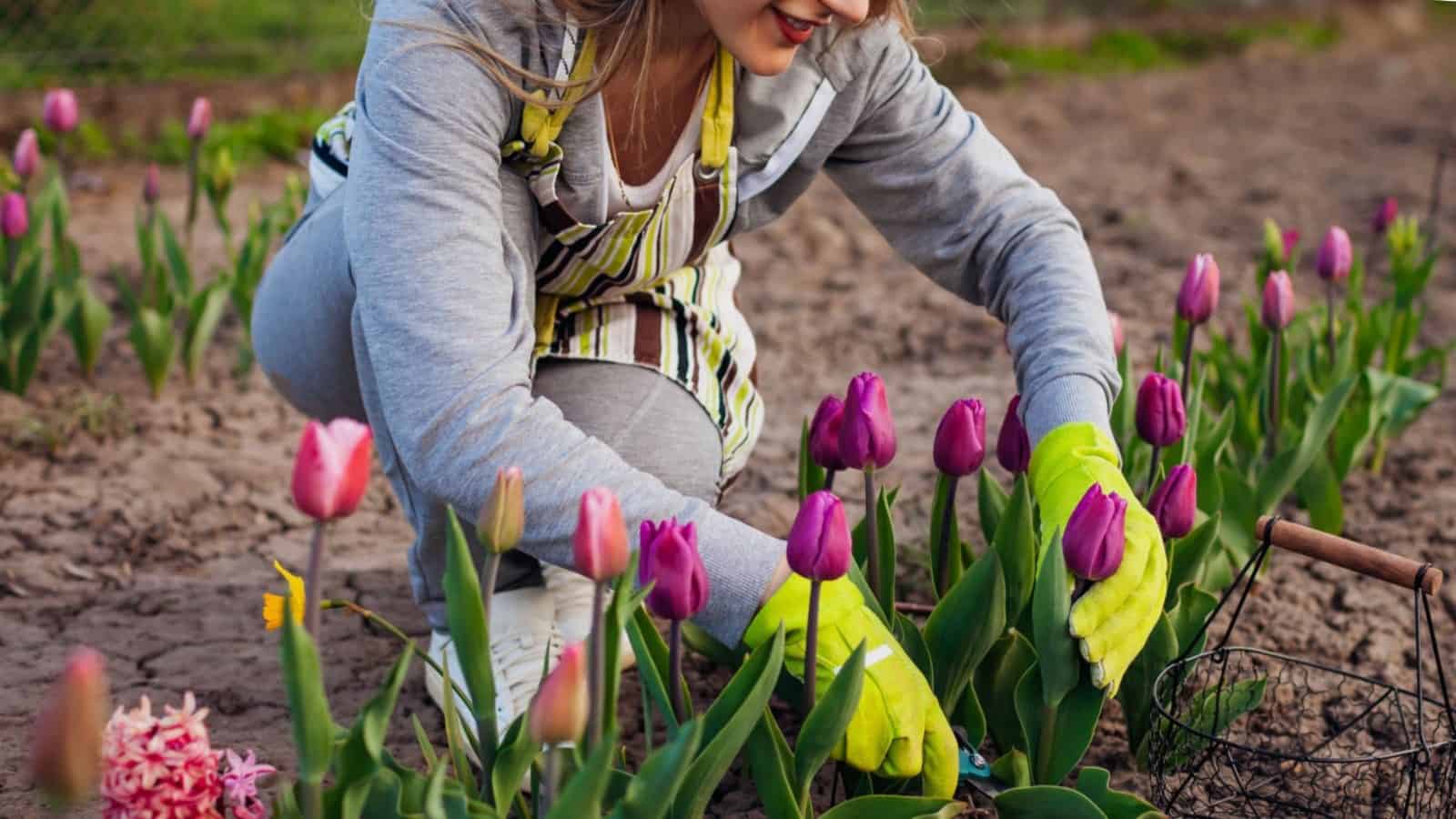It merely doesn’t get increased than the sight of spring flowers! Spring is a pretty time of 12 months, and there’s nothing pretty like seeing the first flowers peeking by after an prolonged, chilly winter.
Even when there’s nonetheless snow on the underside, you’ll have the benefit of early spring bloomers like snowdrops, glory of the snow, and crocuses in your yard. In the event you want to have the benefit of pretty blooms all by means of the spring and into summer season, it’s essential to plan your planting fastidiously.
Plan your vegetation by choosing annuals or perennials to produce mounted blooms from early spring until summer season. Be taught the plant’s label and make certain that you give them what they need relating to sunlight.
Choose perennials that will survive winters in your USDA hardiness zone. Some spring-flowering vegetation need to be planted throughout the fall to bloom the following spring.
As a grasp gardener, I’ve included my excessive picks for the 32 best spring flowers it is best to ponder planting. You’ll uncover all of the necessary knowledge on this info, along with the USDA hardiness zones, daylight requirements, and even the soil they like.
By the tip of this info, I’m optimistic you’ll uncover one of the best spring flowers to develop and take care of in your home yard. As always, be at liberty to achieve out you in all probability have any questions or want me in order so as to add totally different flower-growing guides! I’ll maintain together with to the itemizing as we go and maintain it updated yearly.
1. Daffodil
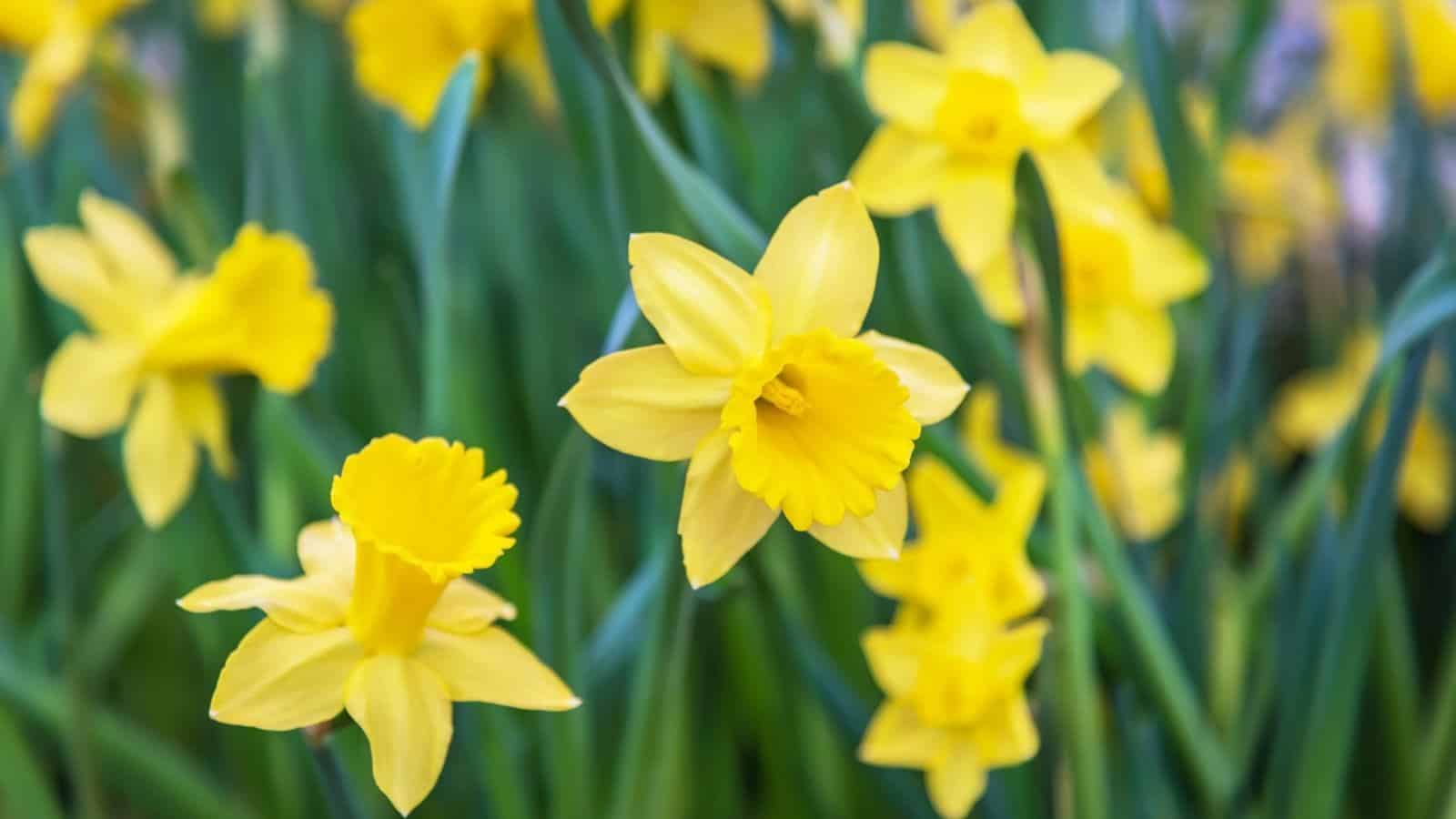
USDA hardiness zone: 3-8
Photo voltaic Publicity: Full photo voltaic to partial shade
Soil Type: Successfully-drained
The daffodil, with its vibrant yellow hue and distinctive trumpet-shaped corona, is a harbinger of spring, sometimes being the first bloom to emerge from the winter soil. This perennial flower, belonging to the Narcissus genus, is a favorite amongst gardeners as a consequence of its low repairs and extreme impression.
What makes the daffodil specific isn’t solely its cheerful look, however moreover its resilience. The daffodil is a hardy bloom that will survive in quite a few conditions, from full photo voltaic to partial shade, and in quite a lot of soil kinds, as long as it is well-drained.
One different distinctive attribute of the daffodil is its functionality to naturalize or multiply and unfold, over time. This allows the gardener to plant as quickly as and profit from the blossoms for a couple of years to come back again.
Any gardener must ponder rising daffodils for his or her versatility and longevity. They’re good for borders and containers and are naturalized in woodland areas or lawns.
Plus, daffodils are deer-resistant, making them an outstanding different for people who keep in areas the place deer are frequent. With their beautiful magnificence and easy care, daffodils are a will need to have in any spring yard.
2. Tulip
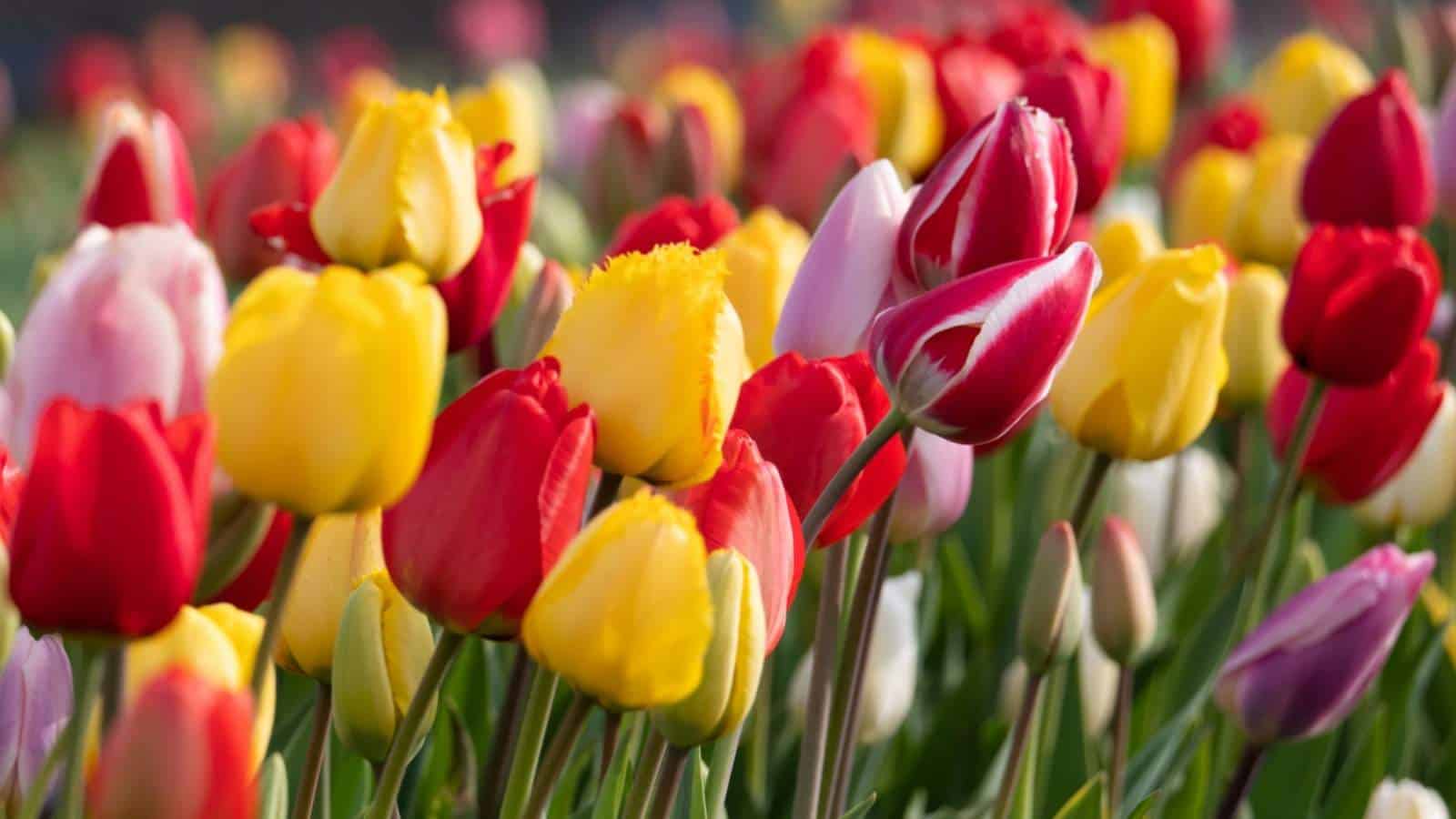
USDA hardiness zone: 3-8
Photo voltaic Publicity: Full Photo voltaic
Soil Type: Successfully-drained
Tulips are a number of the iconic and beloved flowers of the spring season. Originating from Central Asia and Turkey, these perennial bulbs have made their methodology into gardens all through the globe.
With over 3,000 registered varieties, tulips can be found in nearly every coloration of the rainbow, along with multicolored and patterned varieties. They fluctuate from early to late spring bloomers, allowing for a gentle present all by means of the season.
What’s best is that they are hardy flowers that will stand as much as the unpredictable local weather of spring, along with frost and snow.
Moreover, they require minimal care, making them an superior different for every beginer and expert gardeners. Plant them in a sunny spot with well-drained soil, and likewise you’ll be rewarded with a vibrant present that heralds the arrival of spring.
3. Grape Hyacinth
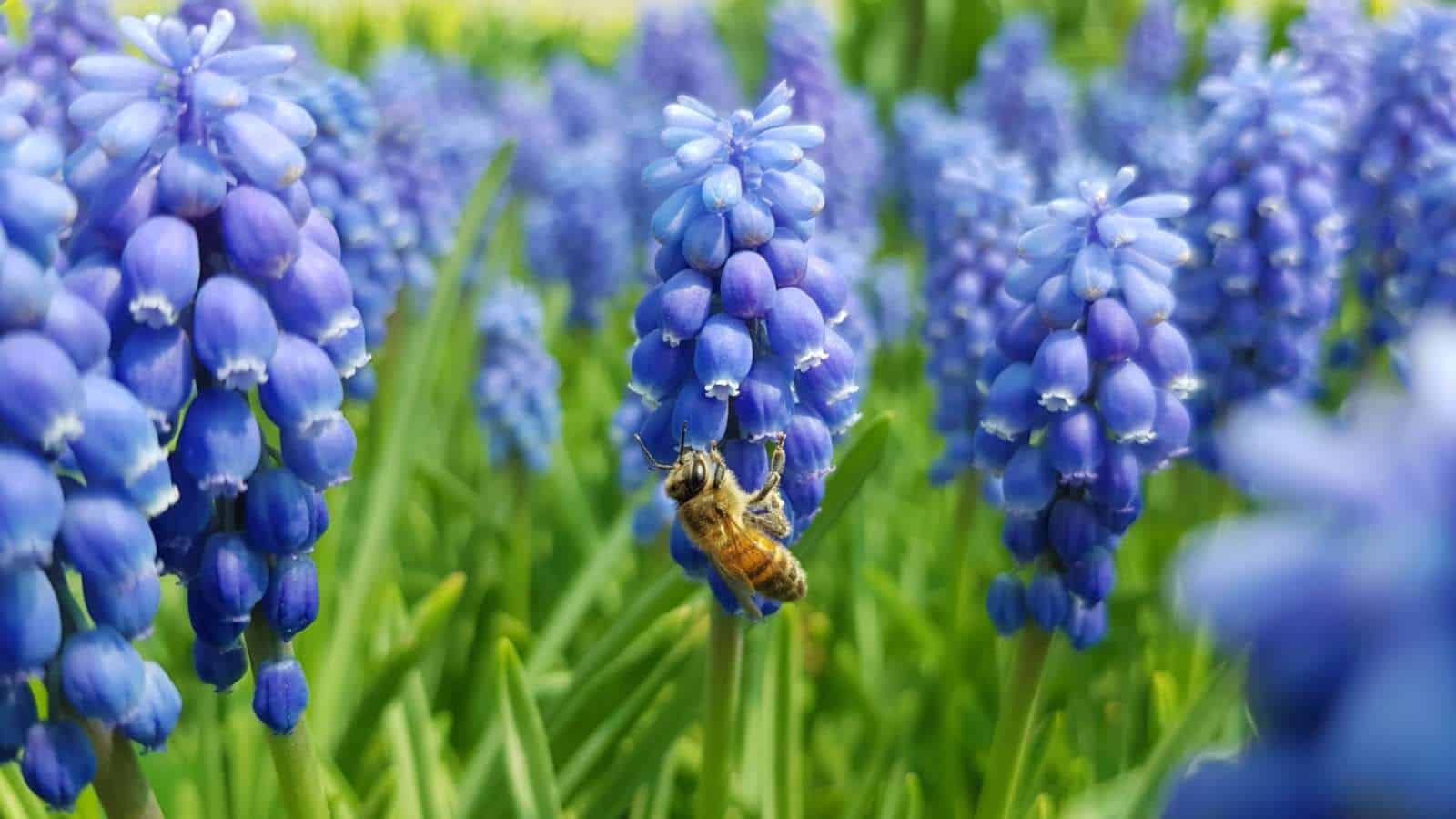
USDA hardiness zone: 4-8
Photo voltaic Publicity: Full Photo voltaic to Partial Shade
Soil Type: Successfully-drained soil
Grape Hyacinth, additionally known as Muscari, is a vibrant spring flower that brings a burst of coloration to any yard. This perennial bulbous plant is believed for its placing cobalt blue or purple clusters of flowers, which resemble tiny grapes.
What makes the Grape Hyacinth specific is its versatility and resilience. It is a hardy plant that will thrive in a variety of climates, from the cool temperatures of USDA hardiness zone 4 to the warmer climates of zone 8.
It is also potential to develop it in full photo voltaic to partial shade, making it adaptable to quite a few yard conditions. Its unusual type and vivid coloration make it a standout in any yard, and its functionality to attract pollinators like bees and butterflies is a bonus.
It’s moreover a low-maintenance plant, requiring minimal care as quickly as established, making it good for every novice and expert gardeners.
4. Crocus
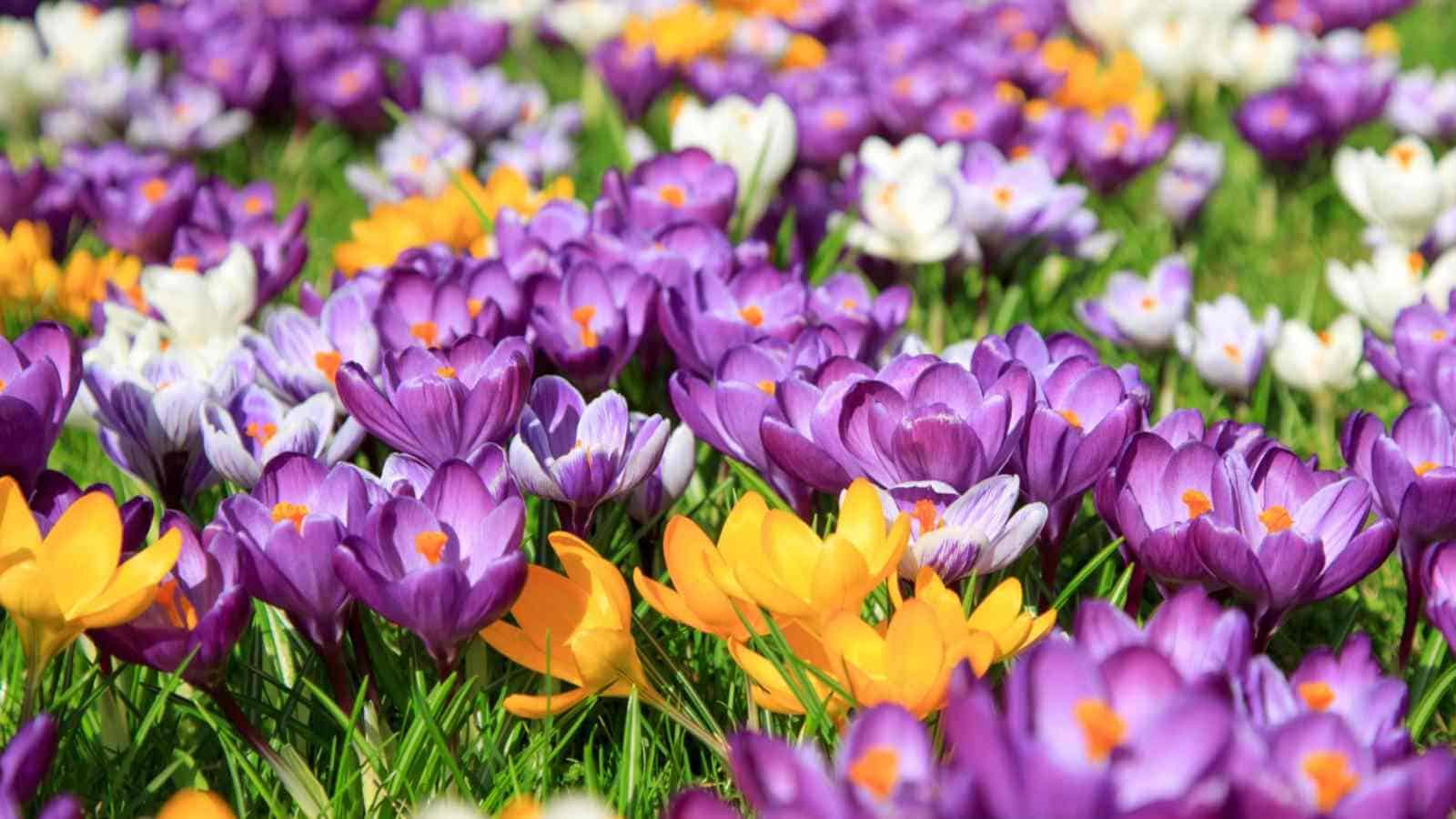
USDA hardiness zone: 3-8
Photo voltaic Publicity: Full Photo voltaic to Partial Shade
Soil Type: Successfully-drained
The Crocus is a perennial flower that hails from the iris family. Acknowledged for its vibrant colors and delicate blooms, this plant is often certainly one of many first to emerge from the soil in spring, making it a herald of hotter local weather to come back again.
What makes the Crocus specific is its resilience and adaptability. No matter its delicate look, it’s a hardy plant that will thrive in a variety of climates, as indicated by its USDA hardiness zone rating.
Its functionality to develop in every full photo voltaic and partial shade makes it a versatile addition to any yard.
Any gardener must ponder rising the Crocus for only a few causes. Its early bloom can convey a splash of coloration to your yard when most totally different vegetation are nonetheless dormant.
It’s comparatively easy to take care of, requiring solely well-drained soil and customary watering. The Crocus has a compact growth habits, making it an outstanding different for gardeners with restricted home.
5. Lily of the Valley
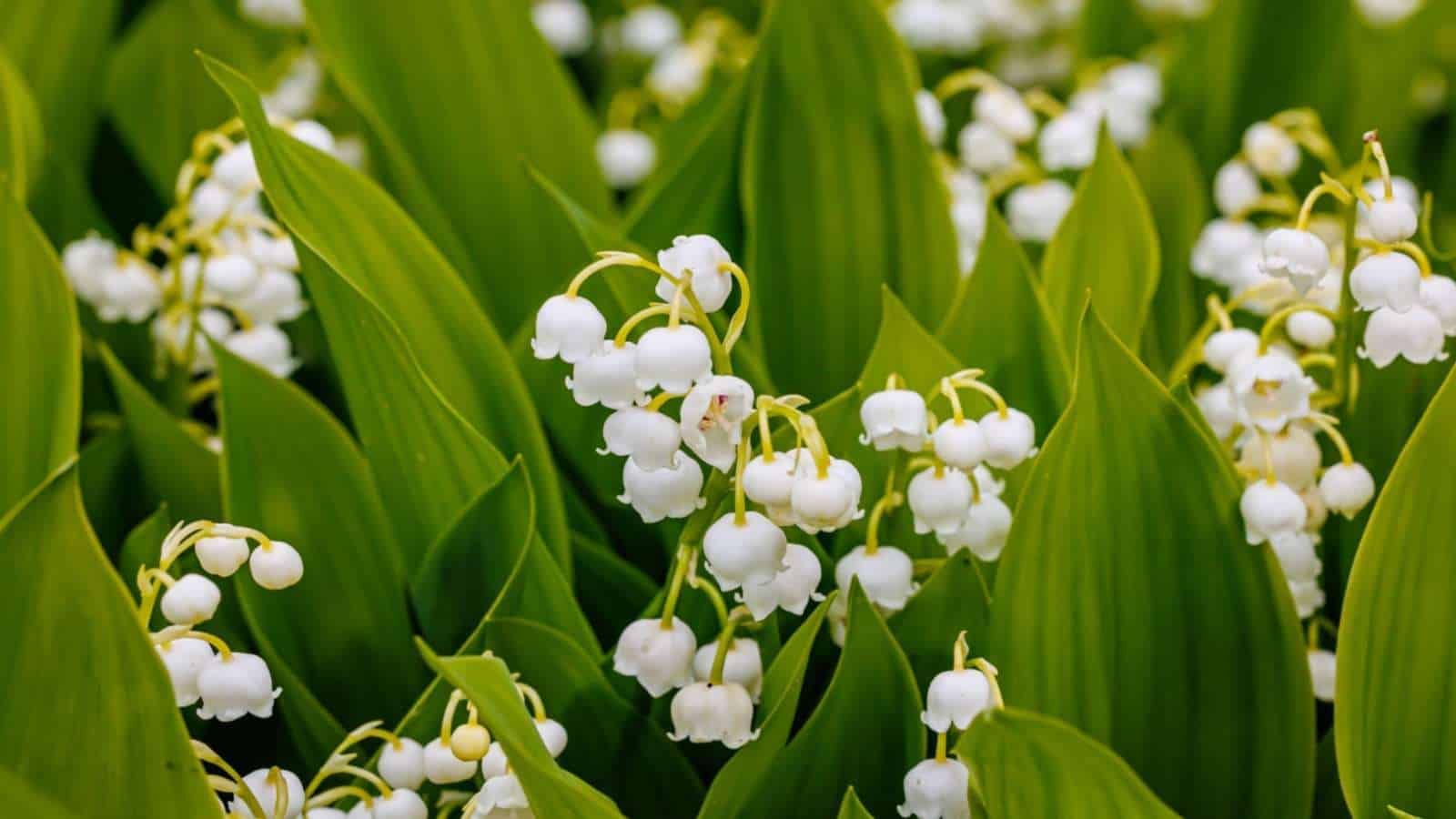
USDA hardiness zone: 2-7
Photo voltaic Publicity: Eager on Full Shade
Soil Type: Rich, Moist, Successfully-Drained Soil
Lily of the Valley, additionally known as Convallaria majalis, is a perennial plant that graces gardens with its delicate, bell-shaped white flowers throughout the spring.
This enchanting plant, native to the cool temperates of Asia and Europe, is a favorite amongst gardeners for its sweet fragrance and its functionality to thrive in shady areas.
No matter its delicate look, it is a hardy plant that will stand as much as chilly temperatures and even unfold in one of the best conditions. Its fragrance is unmatched and has been a popular different in perfumery for a whole bunch of years.
Any gardener must ponder rising the Lily of the Valley for its versatility and sweetness. It could be a super flooring cowl for shady areas, together with a contact of magnificence and a sweet scent.
It requires minimal care as quickly as established and may current a stunning present 12 months after 12 months.
It’s obligatory to note that all components of this plant are poisonous if ingested, so it must be planted with warning in areas accessible to children and pets.
6. Iris
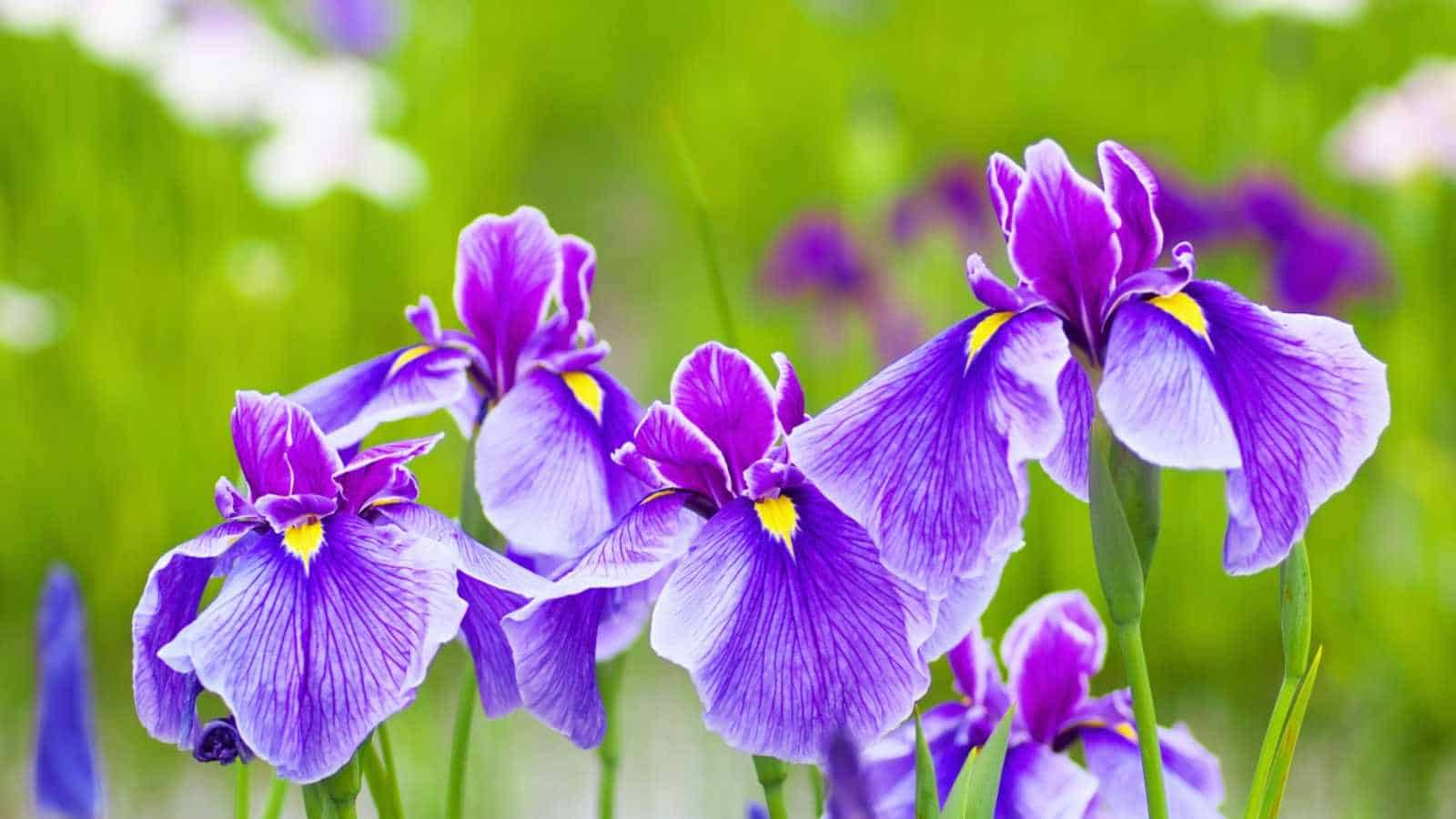
USDA hardiness zone: 3-9
Photo voltaic Publicity: Full Photo voltaic to Partial Shade
Soil Type: Successfully-Drained
The Iris, a perennial plant, is a vibrant addition to any spring yard. With over 300 species, these flowers can be found in a variety of colors, sizes, and kinds, making them a versatile different for gardeners.
What makes the Iris specific is its placing look. The tall, slender stems are adorned with blooms that flaunt three downward hanging petals (falls) and three upright petals (necessities).
This distinctive design, combined with a big spectrum of colors from deep purples to shiny yellows, makes each Iris bloom an interesting sight. They’re comparatively easy to develop and maintain, making them acceptable for every novice and expert gardeners.
Their hardiness allows them to thrive in a variety of climates and conditions, and their blooming season is in spring and early summer season, providing an early burst of coloration when most totally different vegetation are merely starting to awaken from winter.
7. Forsythia
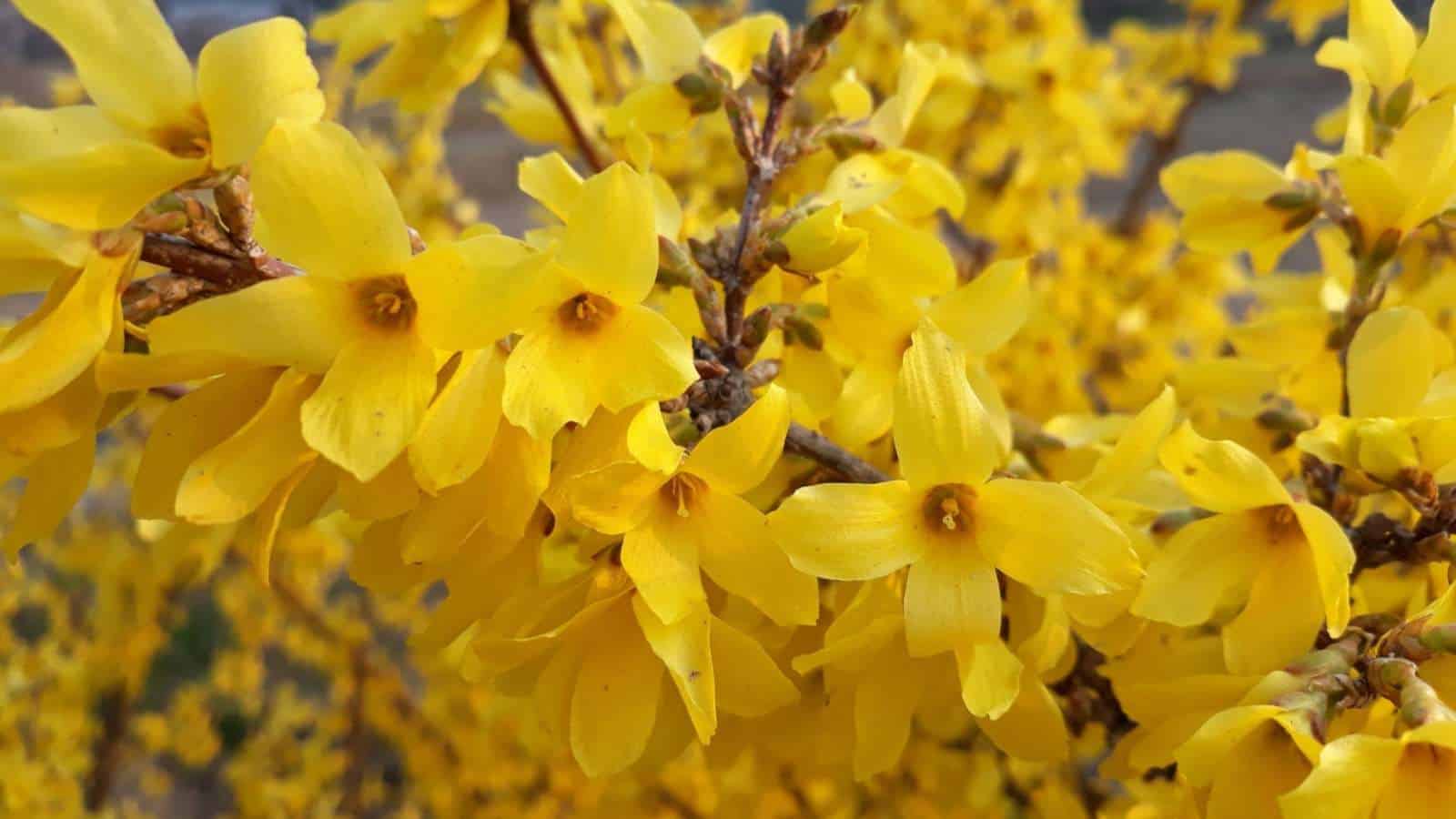
USDA hardiness zone: 5-8
Photo voltaic Publicity: Full photo voltaic to partial shade
Soil Type: Successfully-drained, loamy soil
Forsythia, a harbinger of spring, is a deciduous shrub recognized for its vibrant yellow blossoms that bloom sooner than the leaves unfurl. This plant is a member of the olive family, and it’s native to Jap Asia and Southeastern Europe.
What makes Forsythia specific is its functionality to bloom profusely even after a harsh winter, providing an early provide of nectar for pollinators.
Its flowers are bell-shaped and arranged in clusters, making a spectacular floral present that will rework a boring yard proper right into a vibrant panorama.
Any grasp gardener must ponder rising Forsythia for numerous causes. It’s a low-maintenance plant that’s proof towards most pests and illnesses.
Forsythia could be utilized as a hedge, a specimen plant, or for erosion administration on slopes. Moreover, its functionality to bloom when most vegetation are nonetheless dormant offers coloration and life to your yard at a time when it’s most wished.
8. Azalea
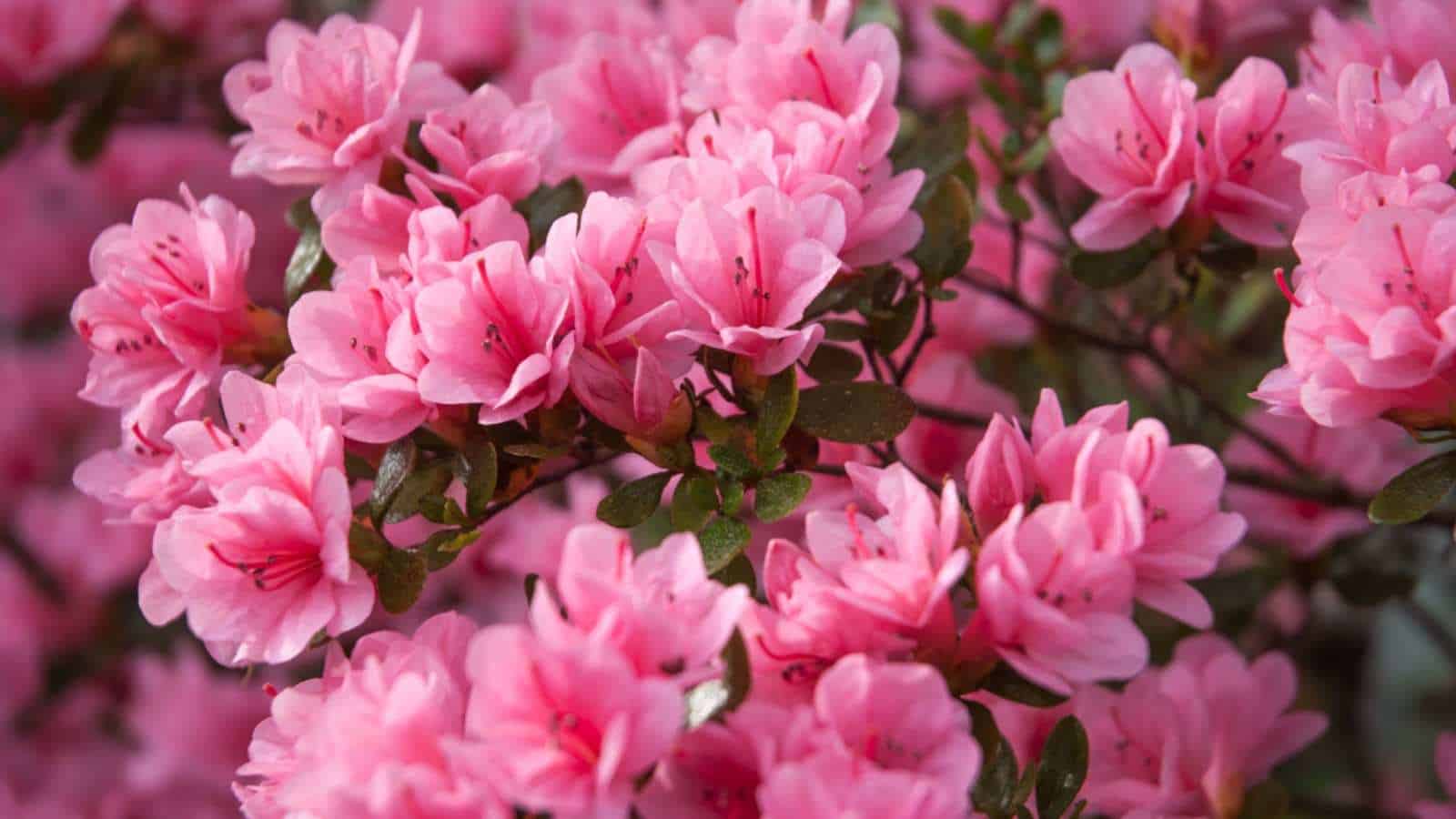
USDA hardiness zone: 5-9
Photo voltaic Publicity: Partial Shade
Soil Type: Successfully-drained, Acidic Soil
Azaleas, a popular different amongst spring flowers, are renowned for his or her vibrant colors and plush blooms. These perennial beauties are part of the Rhododendron family and are native to numerous continents along with Asia, Europe, and North America.
What makes Azaleas specific is their functionality to transform any yard proper right into a riot of colors. Their breathtaking present of vivid hues ranging from deep reds and glossy pinks to snowy whites, make them a visual cope with by means of the spring season.
Any gardener must ponder rising Azaleas not just for their aesthetic enchantment however moreover for his or her adaptability. They’re hardy vegetation that will thrive in a variety of conditions, as long as they’re equipped with one of the best care.
Azaleas need well-drained, acidic soil and partial shade, making them a versatile addition to any yard. They’re moreover proof towards pests, making them a low-maintenance different for novice and expert gardeners.
9. Lilac
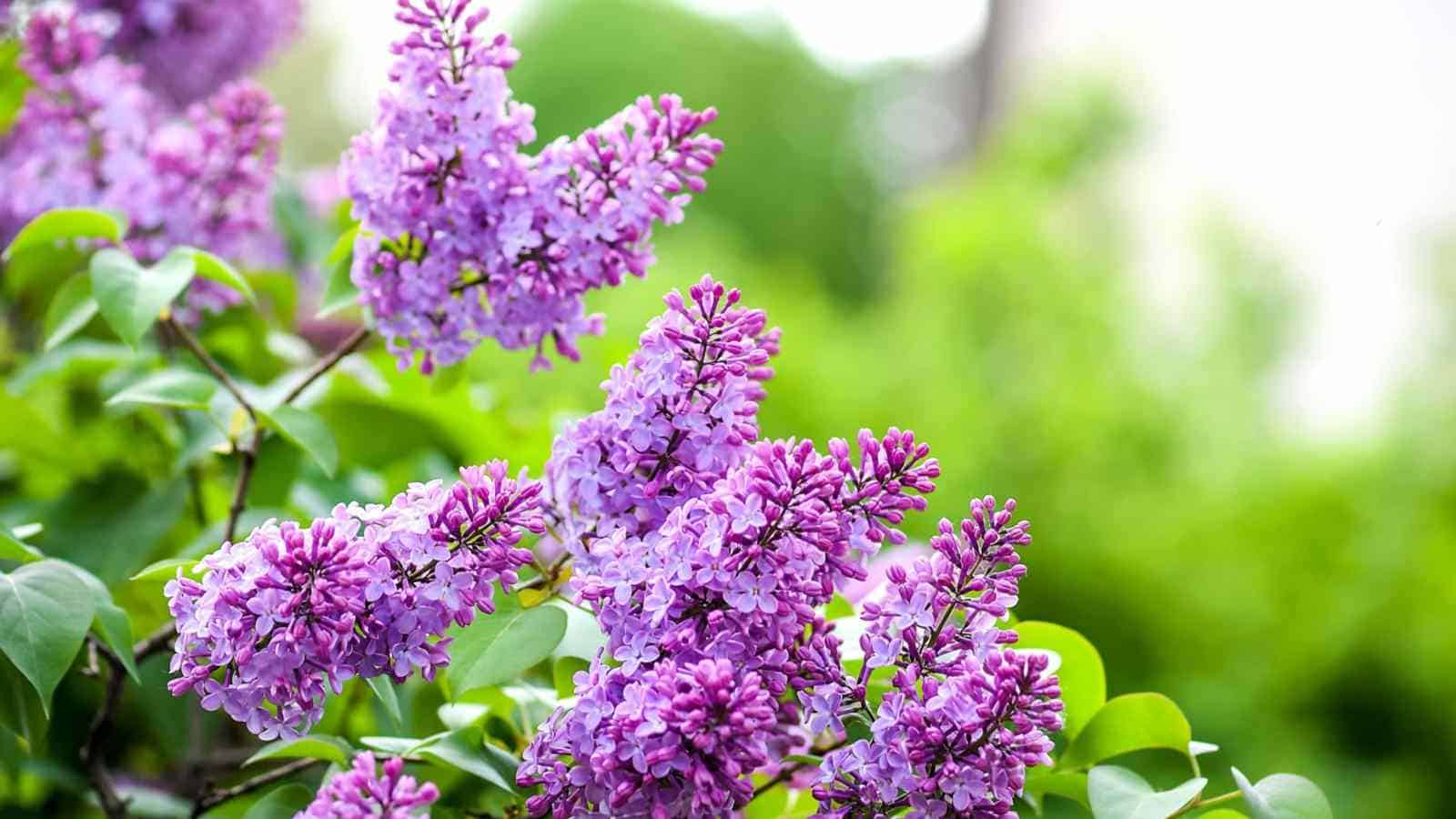
USDA hardiness zone: 3-7
Photo voltaic Publicity: Full Photo voltaic
Soil Type: Successfully-drained, fertile, and barely alkaline
Lilacs are a conventional staple in any spring yard. These deciduous shrubs or small timber are renowned for his or her vibrant, fragrant blooms that grace gardens from late spring to early summer season.
What makes lilacs specific is their enchanting scent. It’s a timeless fragrance that has impressed quite a few perfumes, candles, and totally different aromatic merchandise.
The flowers themselves fluctuate in coloration from pure white to a deep, intense purple, and their heart-shaped leaves current a lush backdrop.
Any gardener must ponder rising lilacs because of they seem to be a comparatively low-maintenance plant. They require minimal pruning and are proof towards most pests and illnesses.
Lilacs moreover entice butterflies and hummingbirds, together with dynamic wildlife to your yard. Their long-lasting blooms make great decrease flowers, bringing a contact of spring indoors.
10. Magnolia
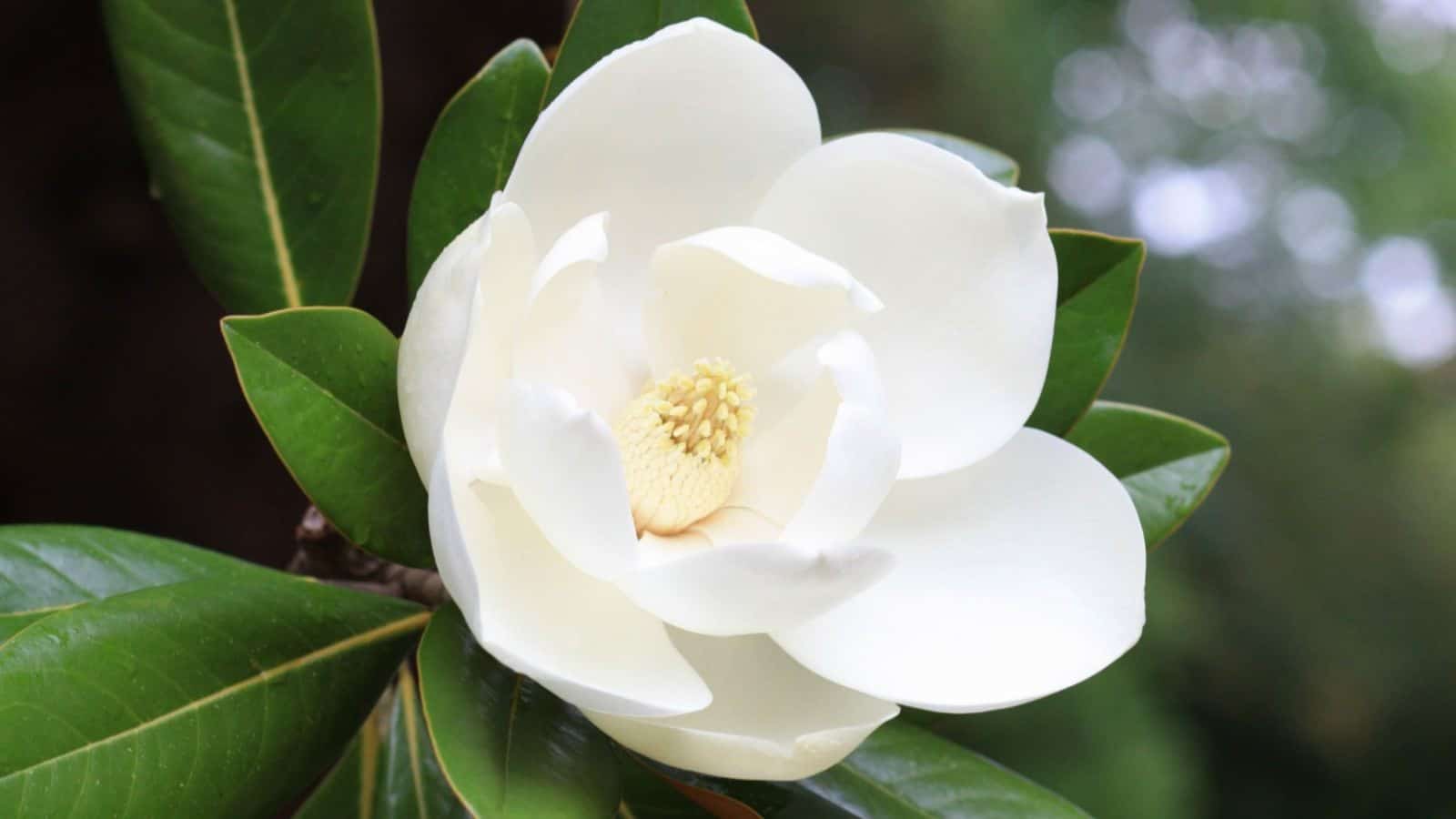
USDA hardiness zone: 5-9
Photo voltaic Publicity: Full Photo voltaic to Partial Shade
Soil Type: Successfully-drained, Acidic to Neutral
The Magnolia tree, an emblem of grace and sweetness, is a genus of flowering vegetation that bloom throughout the spring. These timber are renowned for his or her large, fragrant blossoms that will fill a yard with a sweet, lemony scent.
The flowers fluctuate in coloration from pure white to deep pink, counting on the species.
What makes the Magnolia tree specific is its resilience. No matter its delicate look, it’s a hardy plant that will stand as much as harsh local weather conditions.
It’s a low-maintenance tree that doesn’t require rather a lot pruning and is proof towards most pests and illnesses.
Any gardener must ponder rising a Magnolia tree as a consequence of its aesthetic and sensory enchantment.
It’s a versatile plant that will operate a spotlight in a panorama design, providing a stunning present of blossoms throughout the spring and plush, inexperienced foliage all by means of the rest of the 12 months.
Plus, its fragrant flowers can entice pollinators like bees and butterflies, enhancing the biodiversity in your yard. A Magnolia tree isn’t solely a plant, it’s a pretty addition that will rework your yard proper right into a tranquil sanctuary.
11. Diascia
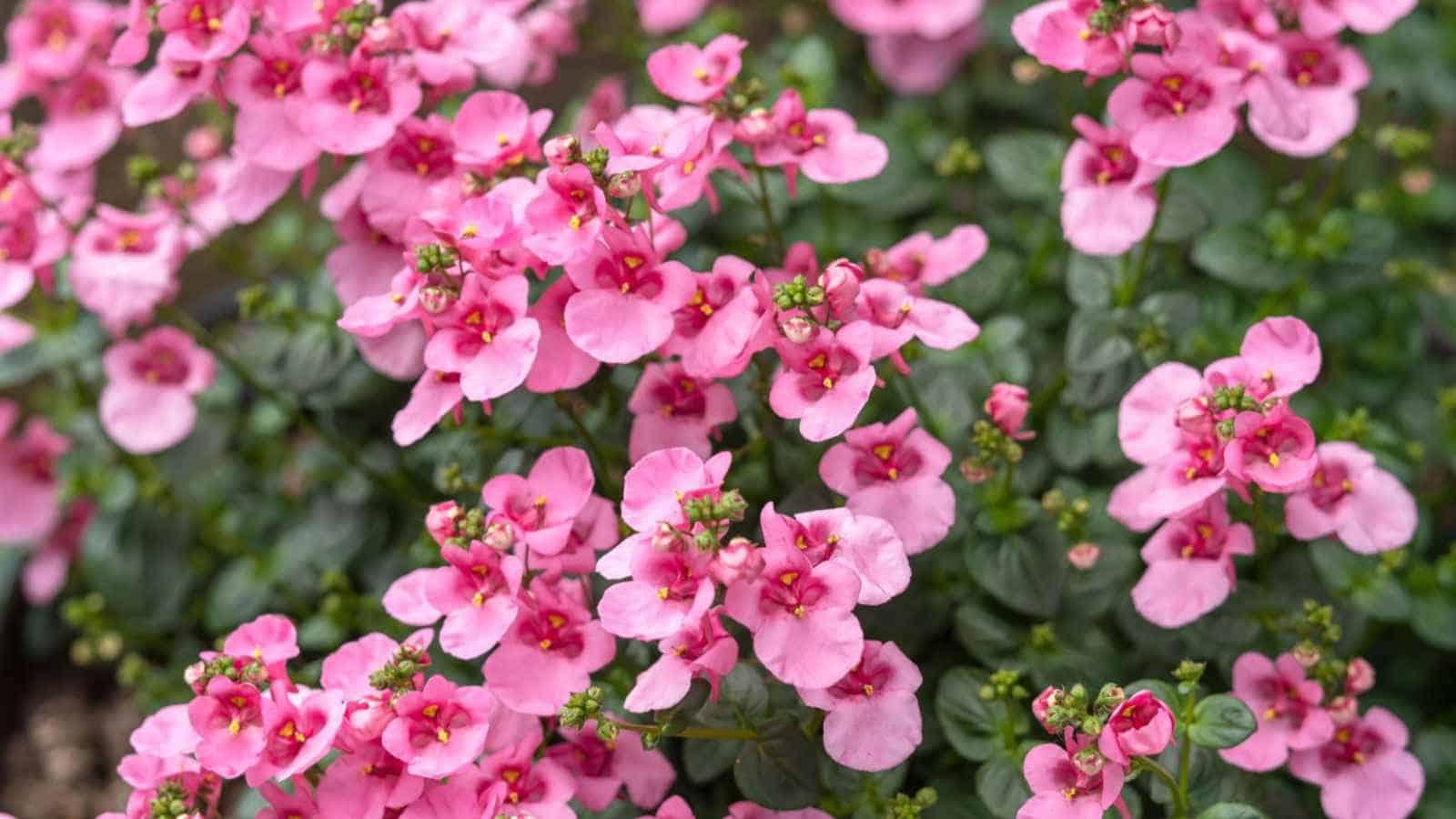
USDA hardiness zone: 5-9
Photo voltaic Publicity: Full Photo voltaic to Partial Shade
Soil Type: Successfully-drained, Loamy
Diascia, additionally known as Twinspur, is a fascinating and versatile plant that gives a contact of magnificence to any yard. This South African native is a spring-blooming perennial that gives a profusion of flowers in shades of pink, coral, and white.
What items Diascia apart is its prolonged blooming interval. In distinction to totally different spring flowers that fade away after only a few weeks, Diascia continues to bloom from spring by fall, providing a relentless splash of coloration in your yard.
Any gardener must ponder rising Diascia for its easy repairs and adaptability. It thrives in a variety of conditions, from full photo voltaic to partial shade, and could also be grown in containers, hanging baskets, or immediately throughout the yard mattress.
With its delicate flowers and extended blooming interval, Diascia is a worthy addition to any yard.
12. Snowdrop
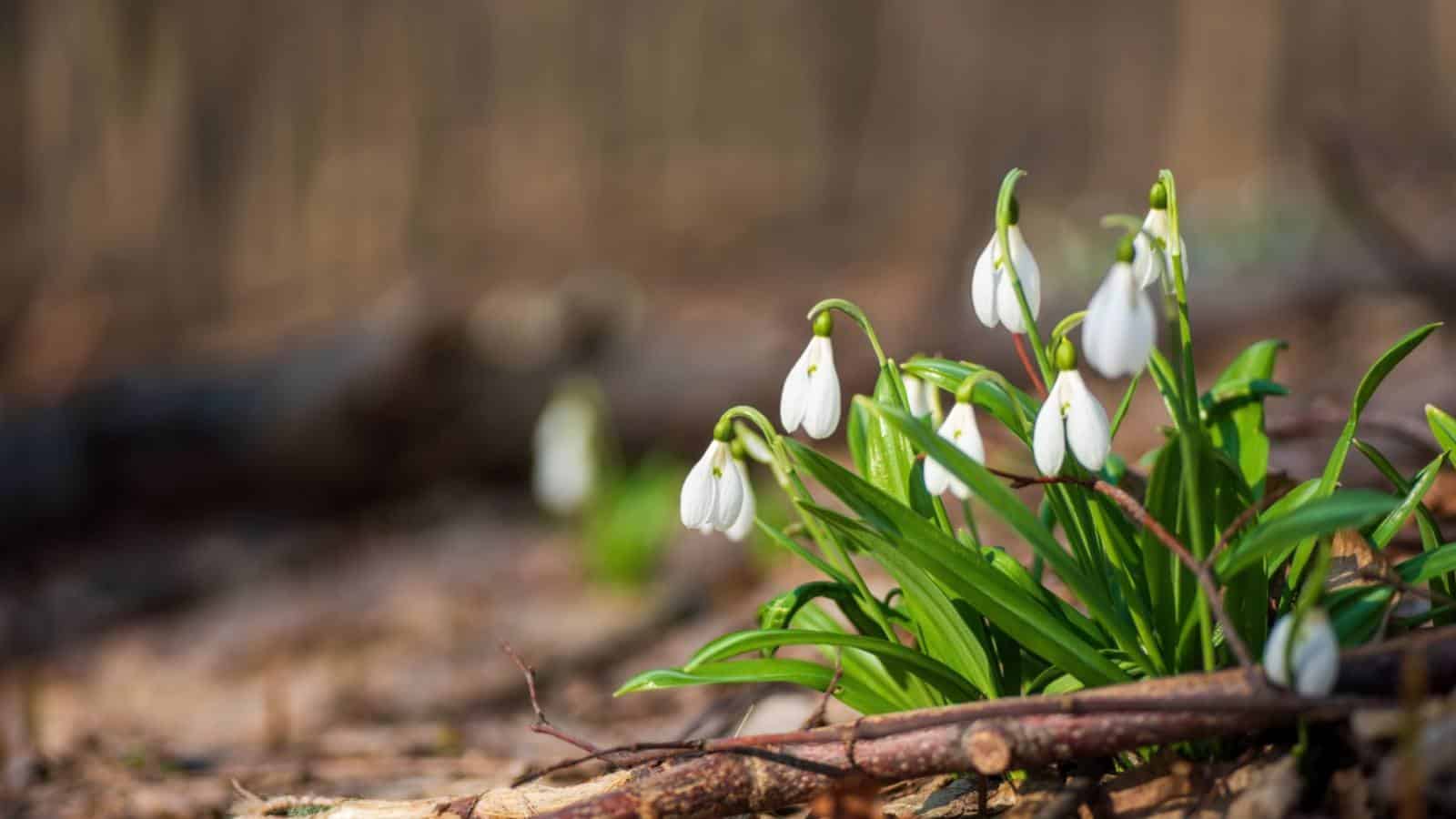
USDA hardiness zone: 3 – 7
Photo voltaic Publicity: Partial Shade
Soil Type: Successfully-drained
The Snowdrop, a herald of spring, is a fragile and enchanting flower that brings pleasure to gardeners and nature lovers alike.
These charming little blooms are among the many many first to look, sometimes pushing by the snow to announce the upcoming arrival of hotter local weather.
What makes the Snowdrop specific is its resilience and tenacity. The flower’s functionality to thrive throughout the harsh winter months, when most totally different vegetation are dormant, is definitely distinctive.
Its shiny white petals and nodding heads current a stark distinction to the terrible winter panorama, making it a standout in any yard all through this season.
Any gardener must ponder rising Snowdrops for his or her magnificence and symbolism. These flowers shouldn’t solely a pleasure to behold, nonetheless moreover they operate a reminder of the resilience of nature and the promise of spring.
No matter their delicate look, Snowdrops are hardy and require minimal care, making them an outstanding different for every novice and expert gardeners.
Their early bloom time can help to attract and provide meals for pollinators, contributing to the overall effectively being of your yard ecosystem.
13. Wallflowers
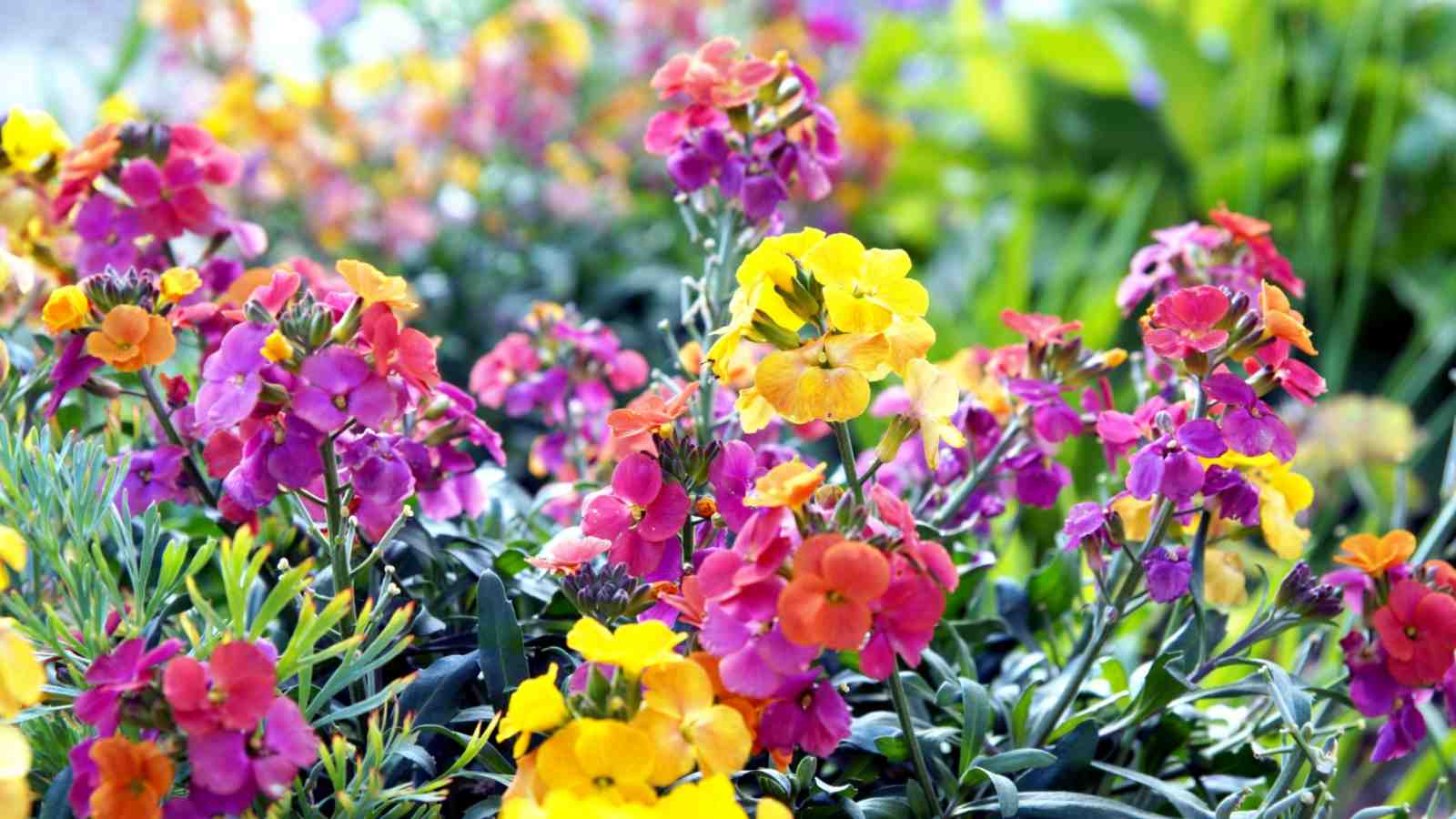
USDA hardiness zone: 7-10
Photo voltaic Publicity: Full photo voltaic
Soil Type: Successfully-drained soil
Wallflowers, scientifically known as Erysimum, are a gaggle of flowering vegetation that convey a burst of vibrant colors to your yard by means of the spring season.
These vegetation are native to rocky and mountainous areas, due to this fact the establish ‘Wallflowers’, as they’re sometimes seen rising on partitions and totally different stony places.
What makes Wallflowers specific is their unimaginable fluctuate of colors, from the brightest yellows and oranges to primarily essentially the most delicate pastels. The flowers are moreover extraordinarily fragrant, together with one different dimension to your yard’s sensory experience.
Any gardener must ponder rising Wallflowers because of they’re comparatively easy to take care of, requiring solely full photo voltaic publicity and well-drained soil. They’re moreover pretty hardy, thriving in USDA hardiness zones 7 by 10.
Wallflowers are good for together with a pop of coloration to your yard, attracting pollinators, and filling your outside home with their sweet fragrance.
Their prolonged blooming interval, from spring to early summer season, ensures your yard stays vibrant for a superb part of the 12 months.
14. Bluebells
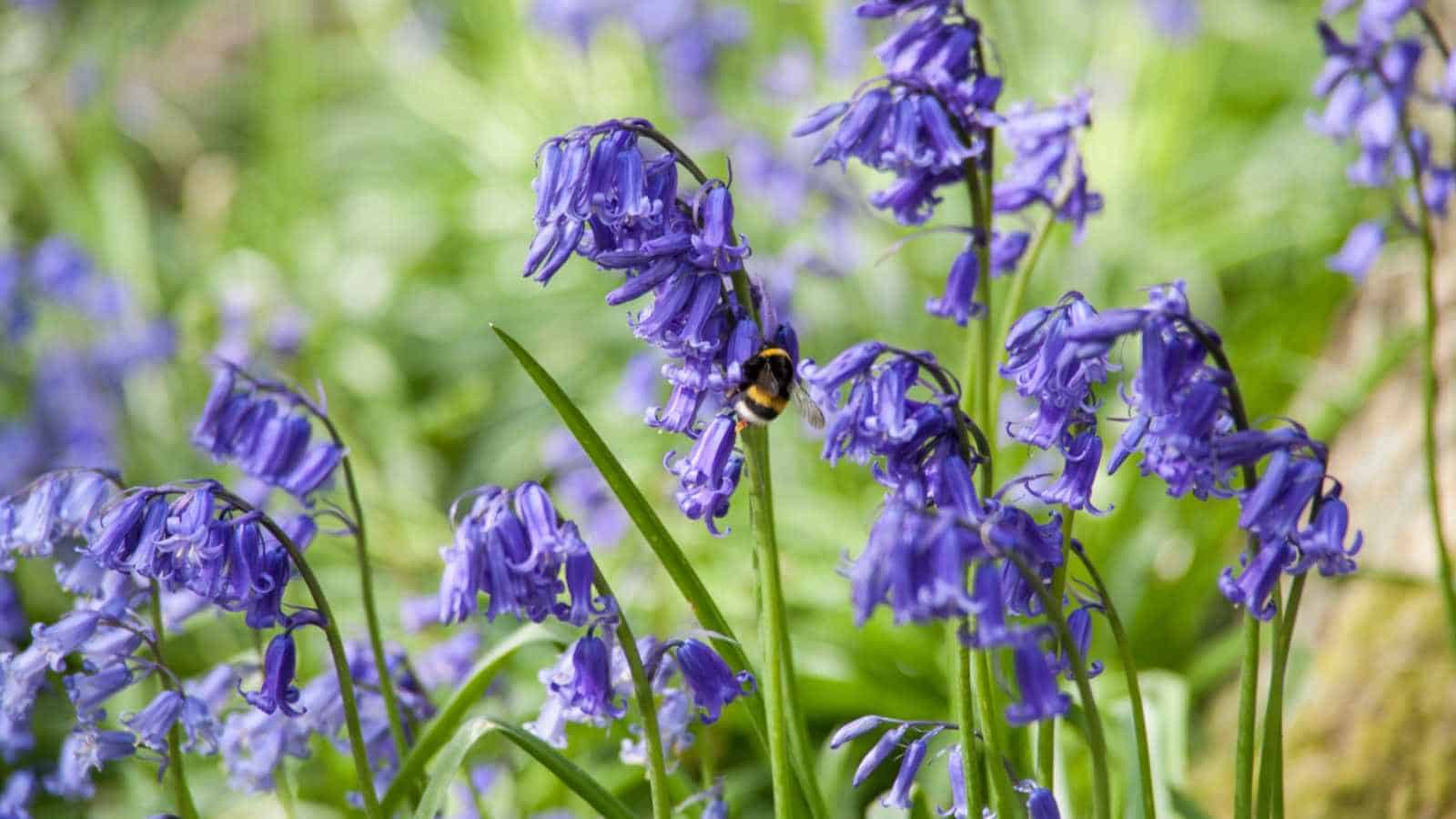
USDA Hardiness Zone: 3-8
Photo voltaic Publicity: Partial Shade
Soil Type: Successfully-drained, Loamy
Bluebells, with their enchanting sea of blue flowers, are a number of the beloved springtime blooms. They seem to be a very good different for naturalistic planting schemes and woodland gardens.
What makes Bluebells specific is their functionality to create a carpet of coloration throughout the yard. Their blue-violet flowers, which might be bell-shaped and droop elegantly from slender stems, are a sight to behold.
They’re moreover recognized for his or her sweet, heady fragrance which offers to their attraction.
Any gardener must ponder rising Bluebells for his or her low repairs and extreme impression. They’re hardy and may thrive in a diffusion of conditions, making them a versatile addition to any yard.
They’re deer-resistant and may entice pollinators, together with an ecological revenue to their aesthetic enchantment. With their beautiful coloration, ease of care, and ecological benefits, Bluebells are a gem in any yard.
15. Overlook-Me-Nots
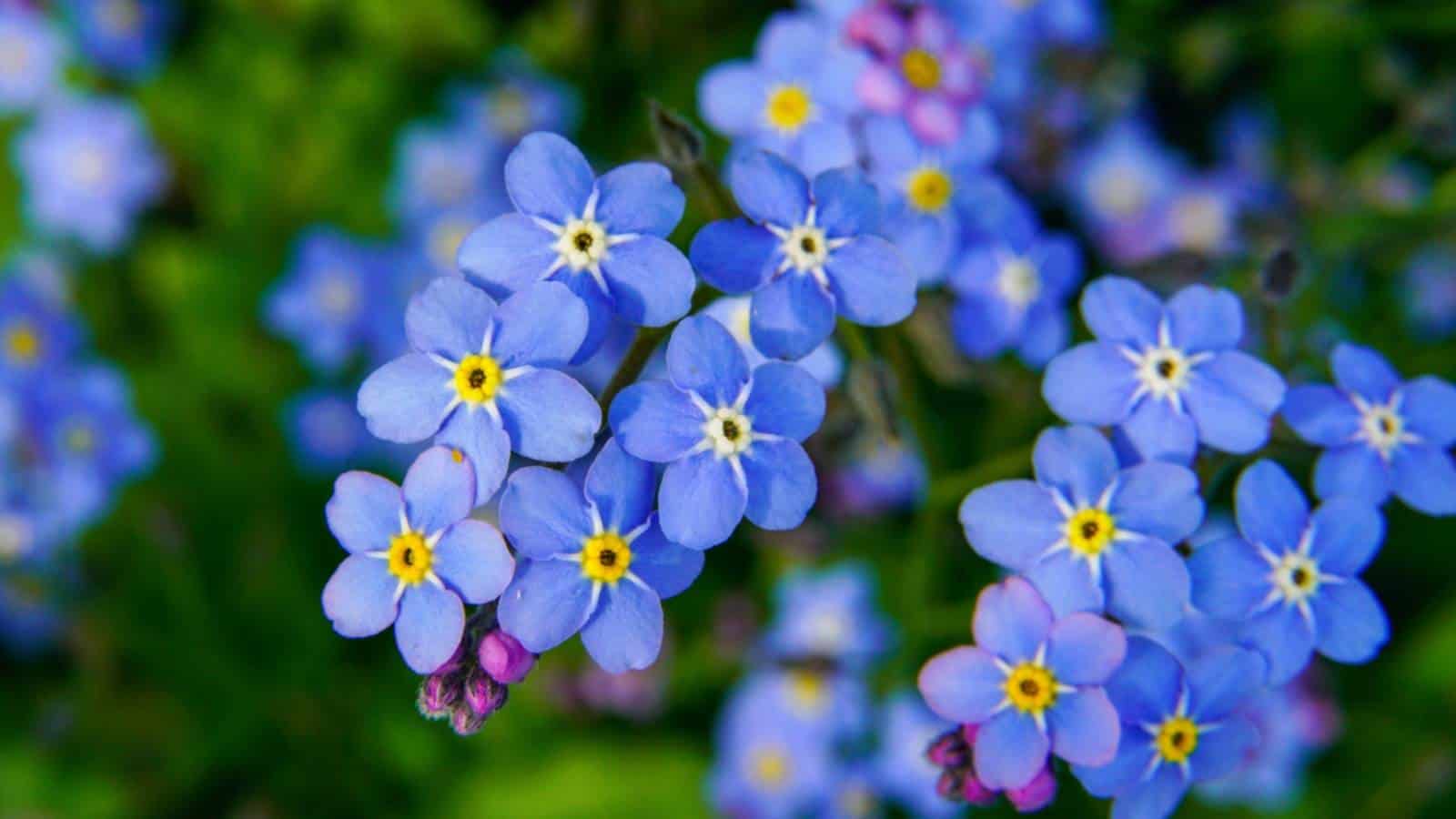
USDA hardiness zone: 3-9
Photo voltaic Publicity: Partial Shade
Soil Type: Successfully-drained, Rich
Overlook-Me-Nots are a fascinating and delicate addition to any yard, notably throughout the springtime. These tiny, sky-blue blooms can create a carpet of coloration and are recognized for his or her heartwarming symbolism of actual love and reminiscences.
What makes Overlook-Me-Nots specific is their functionality to thrive even in primarily essentially the most tough conditions. They’re extraordinarily hardy and may develop in quite a lot of climates and soil kinds.
Their resilience, combined with their pretty, delicate blue flowers, makes them a favorite amongst gardeners.
Any gardener must ponder rising Overlook-Me-Nots not just for their aesthetic enchantment, however moreover for his or her functionality to attract helpful bugs akin to bees and butterflies.
They’re low repairs, requiring minimal care as quickly as established, and may reseed themselves, making sure a gentle present of blooms 12 months after 12 months. These choices make Overlook-Me-Nots a rewarding and helpful addition to any yard.
16. Foxglove
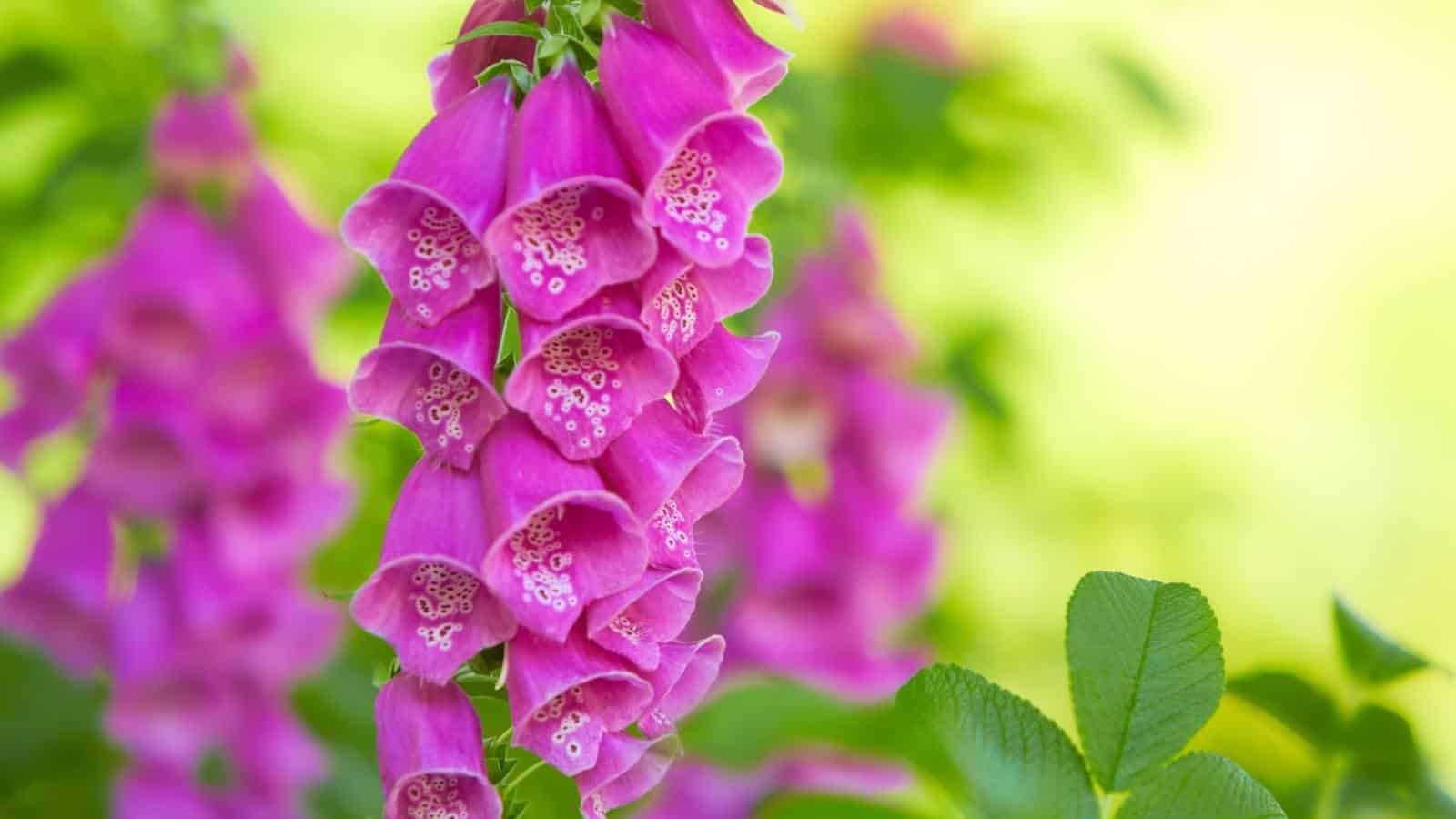
USDA hardiness zone: 4-10
Photo voltaic Publicity: Partial shade to full photo voltaic
Soil Type: Successfully-drained, rich soil
The Foxglove, additionally known as Digitalis purpurea, is an interesting spring flower that brings a novel attraction to any yard. Its towering spires of bell-shaped flowers, ranging from purple to pink, white, and yellow, are a sight to behold.
What makes the Foxglove specific is its dramatic high, reaching as a lot as 6 toes, and its ornamental price.
The blooms shouldn’t solely visually beautiful however moreover entice a variety of pollinators, along with bees and hummingbirds, enhancing the biodiversity of your yard.
Any gardener must ponder rising Foxglove for its versatility and low repairs. It’s a sturdy plant that will thrive in a variety of conditions, from woodland gardens to cottage-style landscapes.
Plus, it’s deer-resistant, meaning it could effectively maintain its magnificence even in areas with extreme deer populations. With its enchanting flowers and easy care, the Foxglove is a rewarding addition to any yard.
17. Peonies
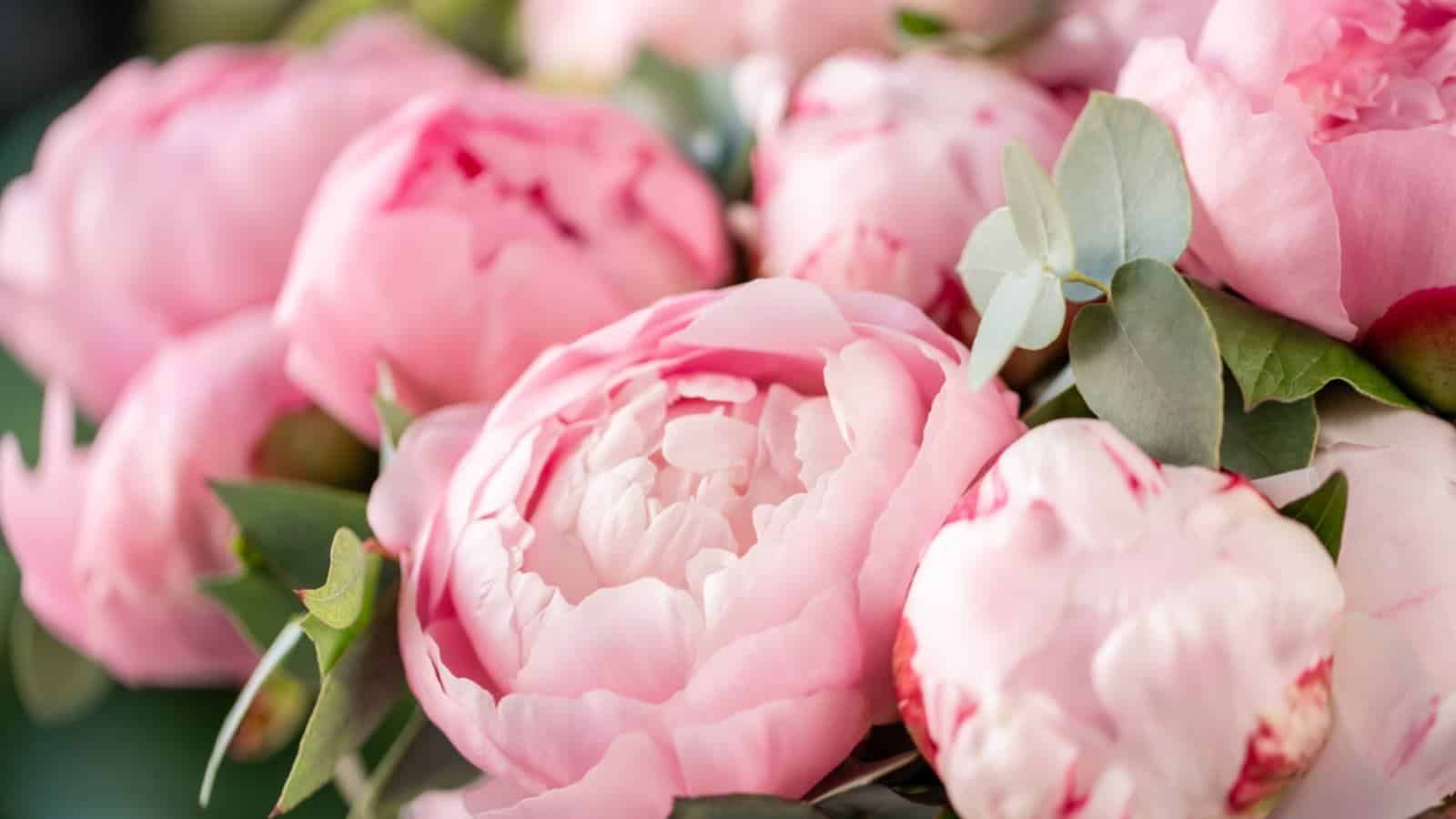
USDA hardiness zone: 3-8
Photo voltaic Publicity: Full Photo voltaic to Partial Shade
Soil Type: Successfully-drained, Fertile
Peonies are a conventional yard staple which had been cherished for his or her lush blooms and vibrant colors for a whole bunch of years. Originating from Asia, Europe, and Western North America, they’re recognized for his or her large, sometimes fragrant flowers.
What makes peonies specific is their longevity. These perennials can keep as a lot as 100 years if accurately cared for, making them a long-lasting addition to any yard.
They arrive in a variety of colors, from pure whites and delicate pinks to deep reds and maroons, providing a spectacular present throughout the spring.
Any gardener must ponder rising peonies for his or her low-maintenance nature and extreme reward. They’re proof towards most illnesses and pests, making them a reliable different for novice and expert gardeners.
Their spectacular blooms make them best possible for decrease flower preparations. With their fascinating magnificence and enduring nature, peonies actually earn their place throughout the coronary coronary heart of every yard.
18. Columbine
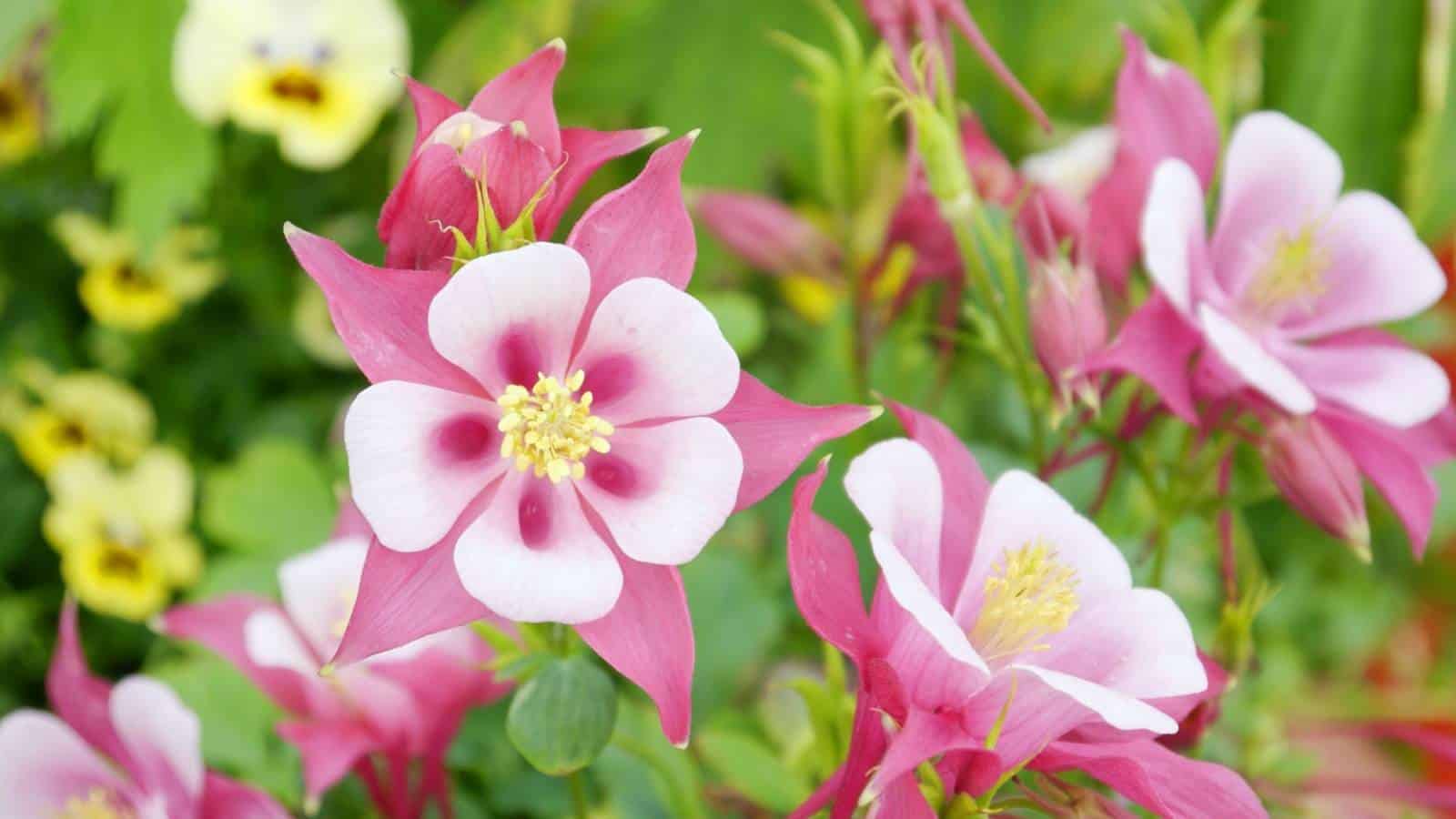
USDA hardiness zone: 3-9
Photo voltaic Publicity: Full Photo voltaic to Partial Shade
Soil Type: Successfully-drained
The Columbine, a perennial favorite amongst gardeners, is a spring flower that is as versatile because it’s pretty. With its distinctive bell-shaped flowers and delicate foliage, it’s a plant that will convey a contact of magnificence to any yard.
From the extreme reds and yellows of the native American species to the fragile pinks and purples of the European varieties, there’s a Columbine to go effectively with every coloration scheme.
The plant will also be recognized for its resilience, able to thrive in a variety of climates and soil kinds. The plant is relatively low-maintenance, requiring solely main watering and occasional pruning.
Plus, it’s an superior different for attracting pollinators like bees and hummingbirds. In short, the Columbine is a plant that gives magnificence, versatility, and ecological benefits, making it a will need to have in any yard.
19. Snowflake
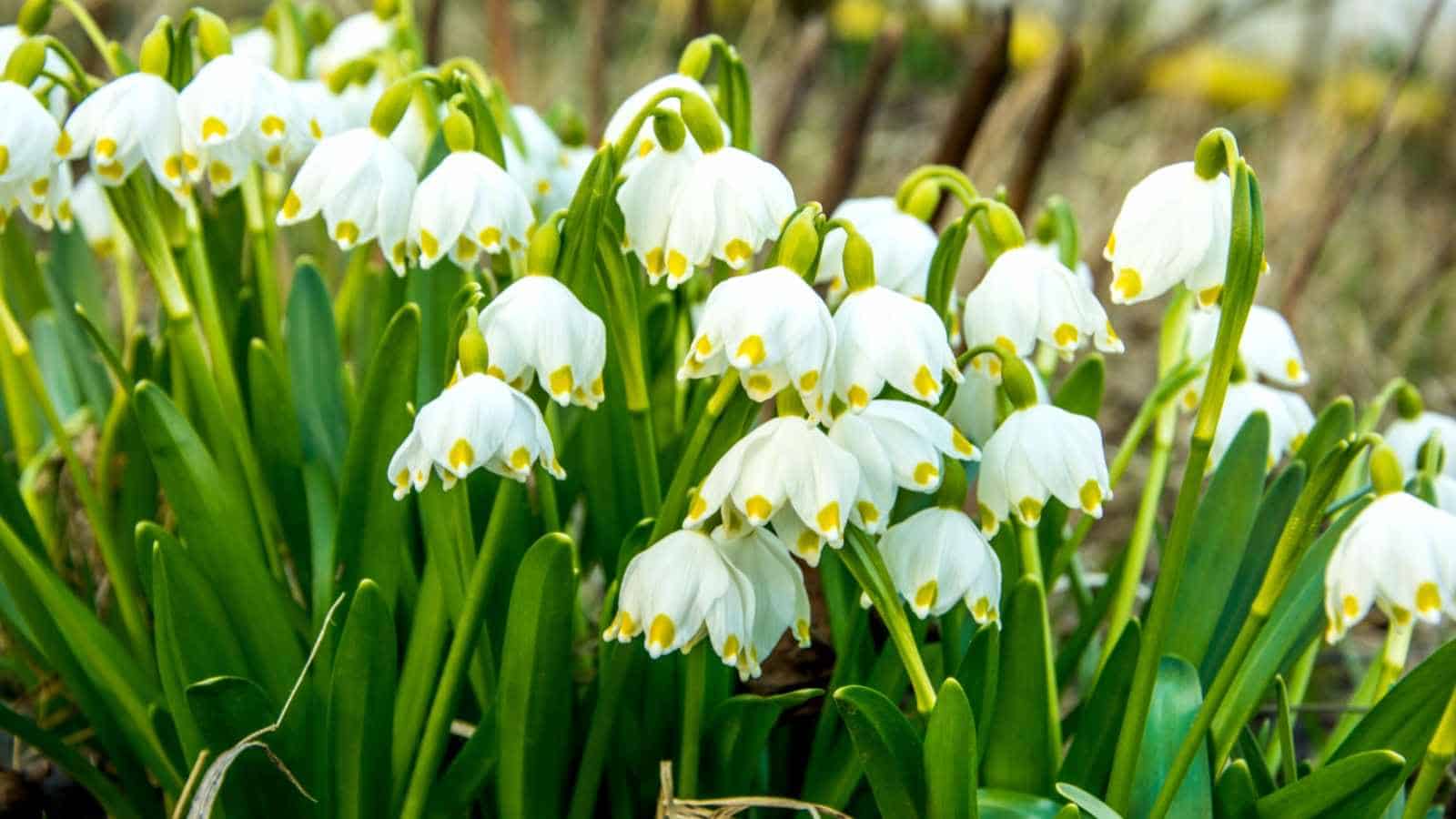
USDA hardiness zone: 3-9
Photo voltaic Publicity: Partial Shade
Soil Type: Successfully-drained Soil
The Snowflake flower, additionally known as Leucojum, is a spring-blooming bulb that brings a novel attraction to any yard.
This plant simply is not as frequent as the usual daffodils or tulips, nonetheless it really stands out with its delicate, bell-shaped flowers that resemble a flurry of snowflakes.
What makes the Snowflake specific is its resilience and adaptability. It thrives in a variety of conditions, from full photo voltaic to partial shade, and in a diffusion of soil kinds, as long as they’re well-drained.
The Snowflake will also be proof towards most pests and illnesses, making it a low-maintenance different for any gardener.
Any gardener must ponder rising the Snowflake for its versatility and sweetness. Its white, bell-shaped blooms add a contact of magnificence to any panorama, and its functionality to naturalize makes it an outstanding different for woodland gardens or naturalized areas.
With its minimal care requirements and beautiful present, the Snowflake is a will need to have in every spring yard.
20. Flowering Quince
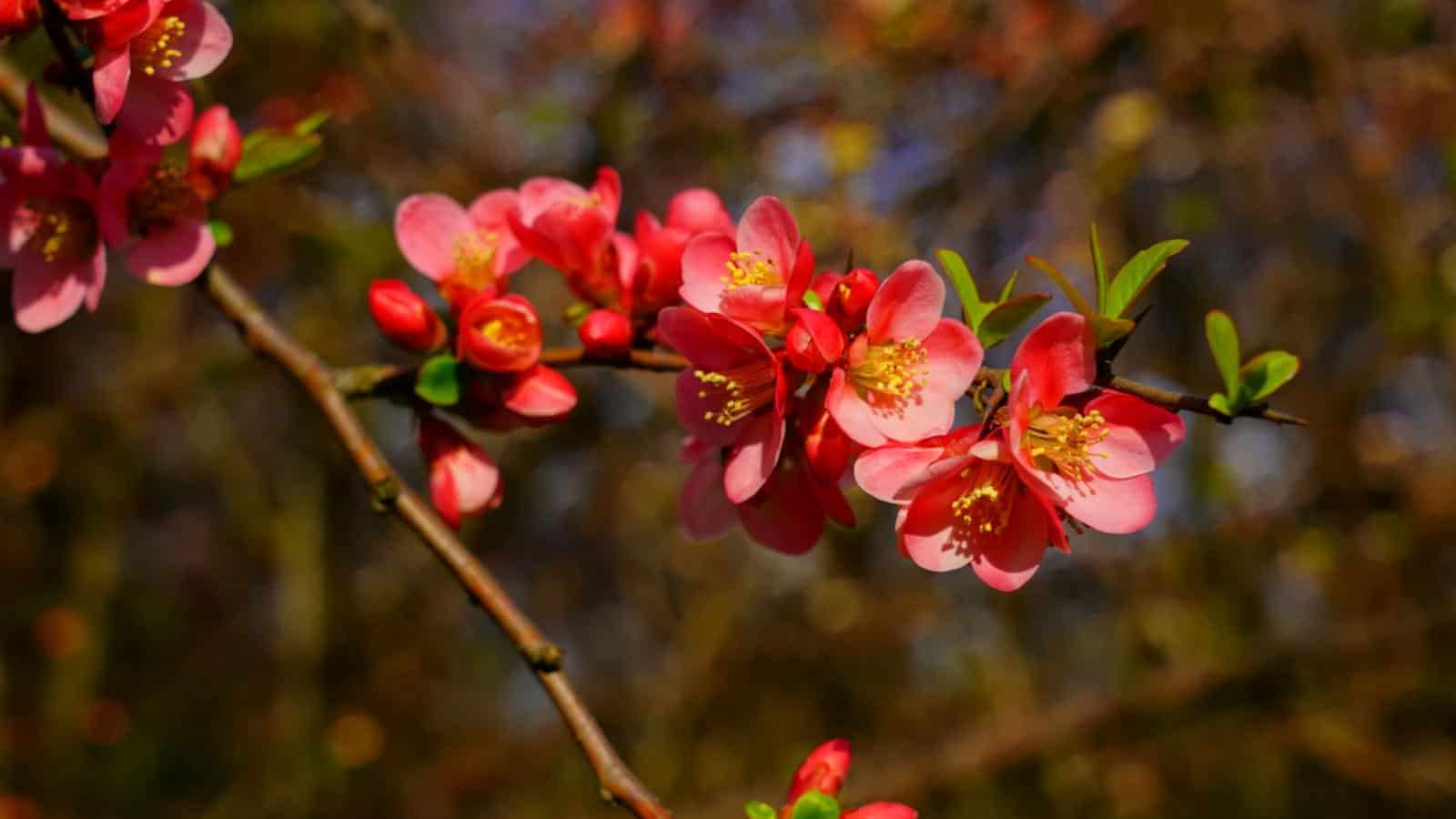
USDA hardiness zone: 4-9
Photo voltaic Publicity: Full Photo voltaic to Partial Shade
Soil Type: Successfully-drained, Loamy
The Flowering Quince, a harbinger of spring, is a deciduous shrub that is renowned for its beautiful early blooms. This plant brings a burst of coloration to your yard, even sooner than totally different vegetation have begun to wake from their winter slumber.
What makes the Flowering Quince specific is its hardy nature and vibrant, cup-shaped flowers. These flowers, ranging in coloration from pink and pink to white, current a placing distinction in opposition to the darkish inexperienced foliage.
The blooms moreover entice a variety of pollinators, making it an outstanding plant for supporting native wildlife.
Any gardener must ponder rising the Flowering Quince because of it is a low-maintenance plant that will thrive in a variety of conditions. It’s not fussy about soil, tolerates drought, and may even stand as much as some shade.
It’s a implausible different for these wanting in order so as to add some early spring coloration to their yard. With its hardy nature and pleasant blooms, the Flowering Quince is a rewarding addition to any yard.
21. Pansy
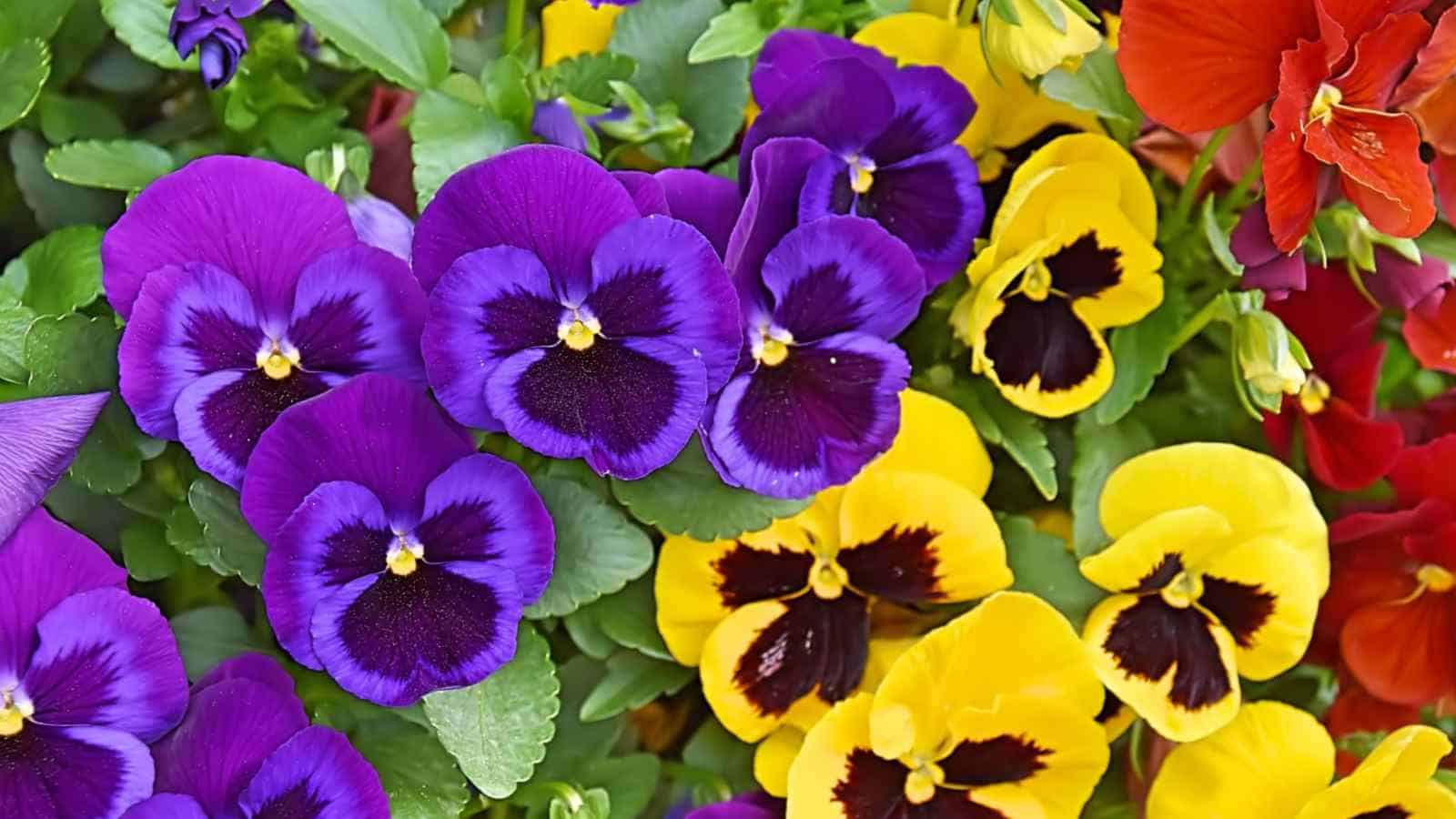
USDA Hardiness Zone: 6-10
Photo voltaic Publicity: Full to Partial Photo voltaic
Soil Type: Successfully-drained, rich in pure matter
The Pansy is a fascinating spring flower that brings a splash of coloration to any yard. Acknowledged for his or her distinctive “faces” and every kind of vibrant hues, these flowers are a popular different for gardeners all through the globe.
What makes the Pansy specific is its resilience and adaptability. No matter their delicate look, Pansies are hardy flowers that will stand as much as cooler temperatures.
They’re moreover adaptable, thriving in a diffusion of photo voltaic publicity conditions from full photo voltaic to partial shade.
Any gardener must ponder rising Pansies for his or her aesthetic enchantment and low repairs requirements. These flowers are easy to develop, making them an outstanding different for newcomers.
In addition to, Pansies are good for together with coloration to borders, containers, and hanging baskets. Their prolonged blooming interval, from spring to early summer season, ensures a yard energetic and coloration for months on end.
22. Primrose
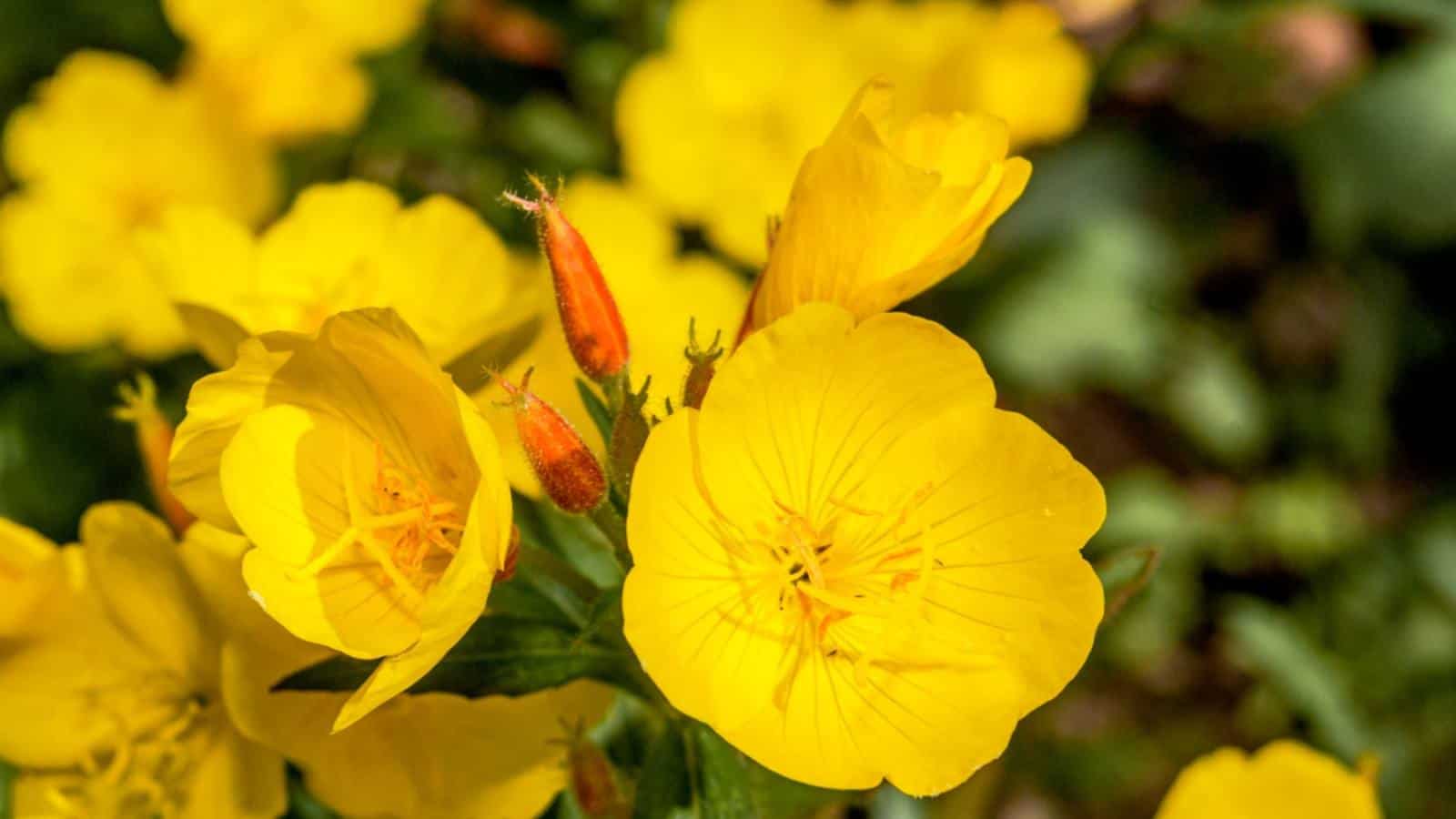
USDA hardiness zone: 4-8
Photo voltaic Publicity: Eager on Full Shade
Soil Type: Successfully-drained, Humus-rich
Primroses, with their vibrant hues and delicate petals, are a cherished herald of spring. These perennial vegetation are recognized for his or her functionality to thrive in cooler climates and produce a splash of coloration to a yard merely when it’s wished most.
What makes the Primrose specific is its giant variety of colors and patterns. From daring yellows and reds to delicate pinks and whites, there’s a Primrose to go effectively with every gardener’s palette.
Some varieties even boast a pretty lacy edge, together with a further dimension to their attraction. Plus, hey can tolerate frost and like cooler temperatures, making them an outstanding different for early spring planting.
Their functionality to thrive in a fan of full shade means they may brighten up these darker corners of your yard. With their cheerful colors and resilience, Primroses are a will need to have in any spring yard.
23. Lenten Rose
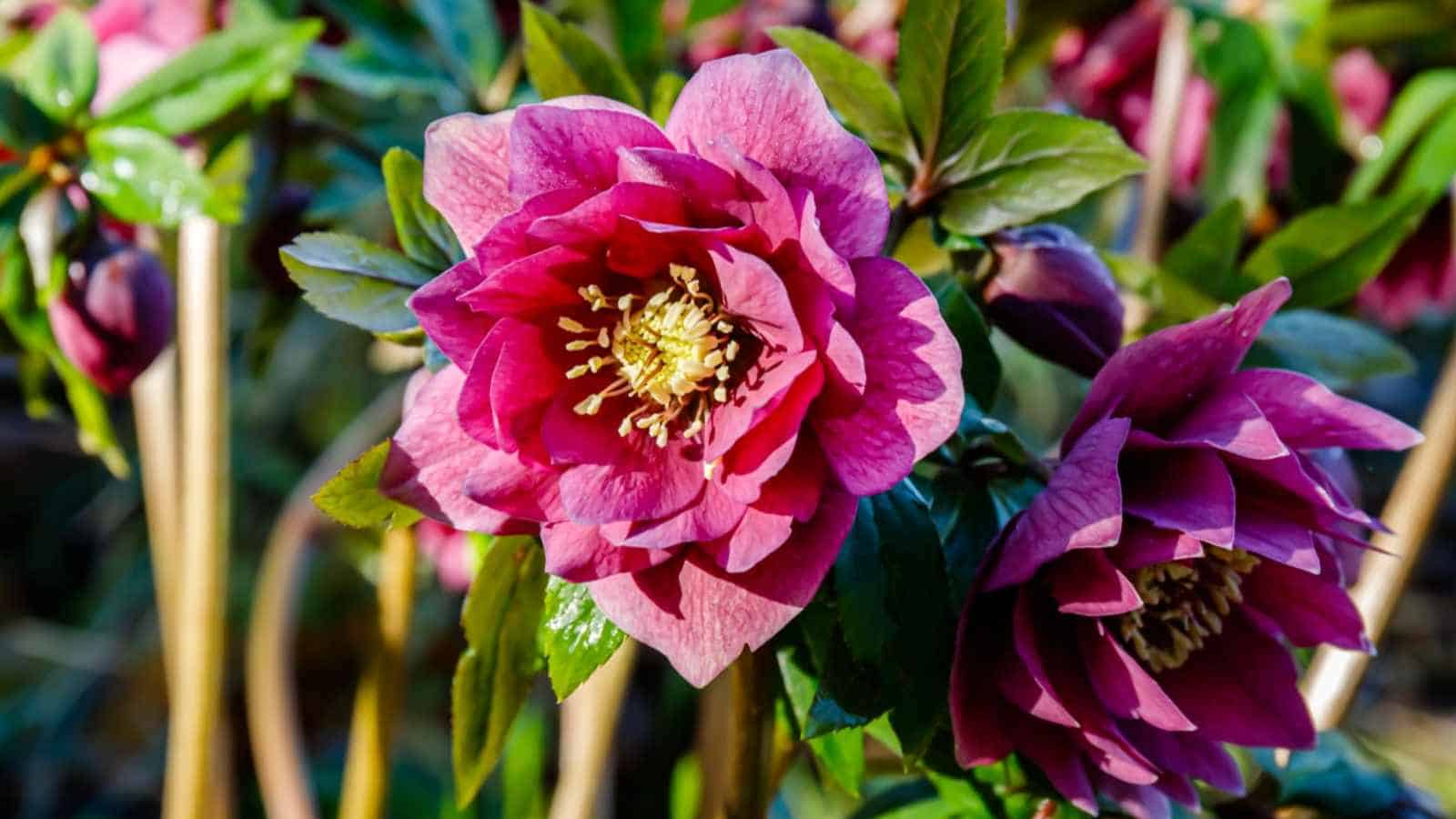
USDA hardiness zone: 4-9
Photo voltaic Publicity: Eager on Full Shade
Soil Type: Successfully-drained, Rich in Pure Matter
The Lenten Rose, scientifically known as Helleborus orientalis, is an interesting spring flower that is cherished amongst gardeners for its attraction and resilience. This perennial plant, no matter its establish, simply is not a rose nonetheless belongs to the buttercup family.
What makes the Lenten Rose actually specific is its functionality to bloom in late winter to early spring, sometimes by means of the interval of Lent, due to this fact its frequent establish.
Its flowers, which fluctuate in coloration from white and pink to purple and even nearly black, current a stunning distinction to the terrible winter panorama.
Any gardener must ponder rising the Lenten Rose for numerous causes. Not solely does it add coloration to the yard all through a time when most totally different vegetation are dormant, nonetheless moreover this can be very resilient, being proof towards every deer and plenty of frequent plant illnesses.
As quickly as established, it requires little repairs, making it an outstanding different for every novice and expert gardeners. The Lenten Rose is a really distinctive plant that will rework any yard proper right into a winter wonderland.
24. Glory of the Snow
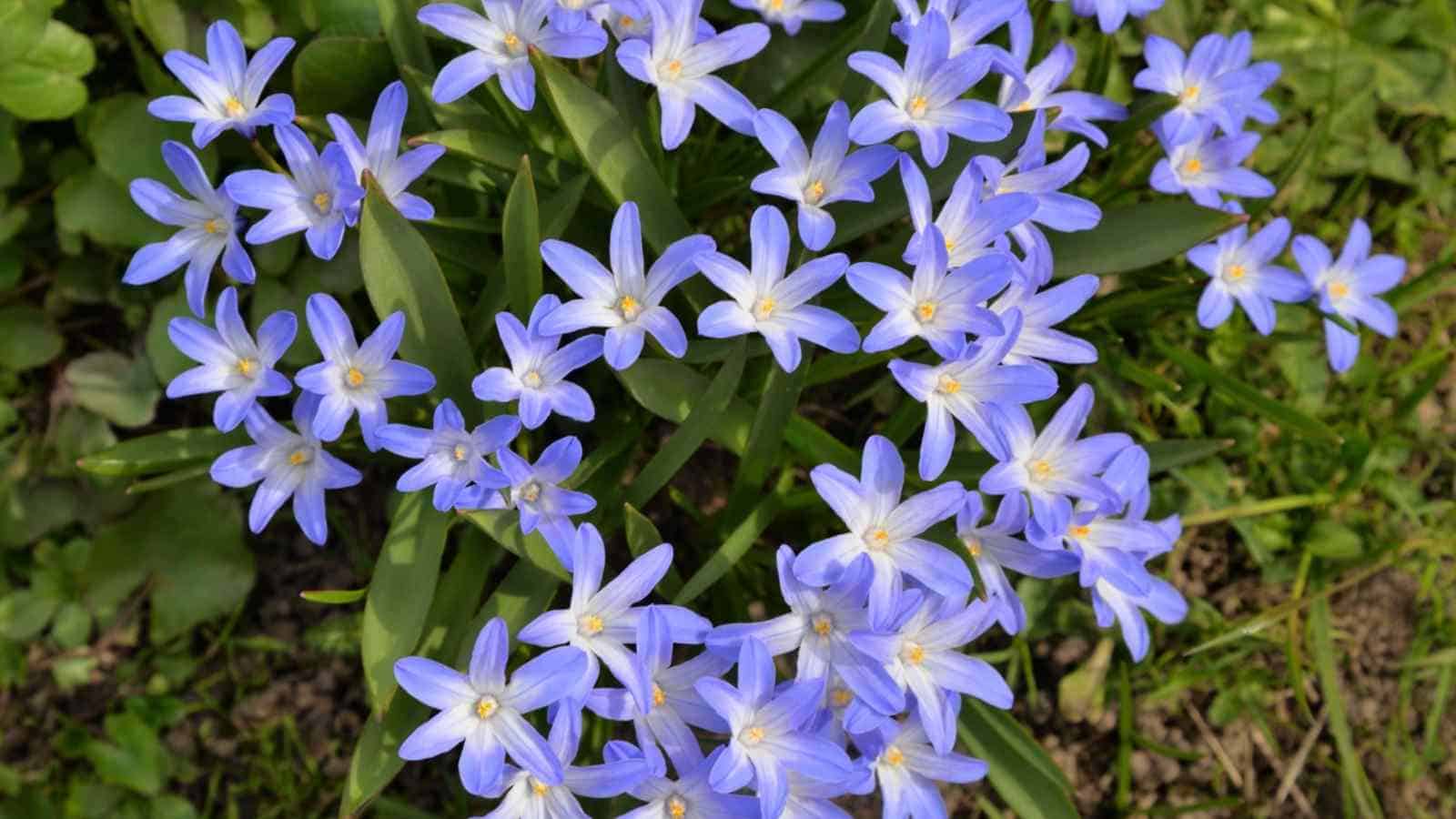
USDA hardiness zone: 3-8
Photo voltaic Publicity: Full Photo voltaic to Partial Shade
Soil Type: Successfully-drained
The ‘Glory of the Snow’ is a fascinating herald of spring, blooming profusely even by late winter snow. This hardy bulbous perennial is native to alpine areas nonetheless has tailor-made correctly to a diffusion of climates and conditions.
What makes it specific is its tenacity and early blooming interval. It’s commonplace to see these vibrant blue, pink, or white flowers pushing by the snow, due to this fact their establish.
The flowers are star-shaped, with each petal marked by a darker stripe down the center, making a placing distinction in opposition to the white snow.
Any gardener must ponder rising ‘Glory of the Snow’ for its functionality in order so as to add early coloration to the yard. It’s moreover an outstanding different for naturalizing, as a result of it self-seeds readily and might return 12 months after 12 months.
It’s deer and rabbit-resistant, making it a wise different for these with wildlife company. Its low-growing habits makes it good for rock gardens, borders, or underplanting taller spring bulbs.
25. Lupines
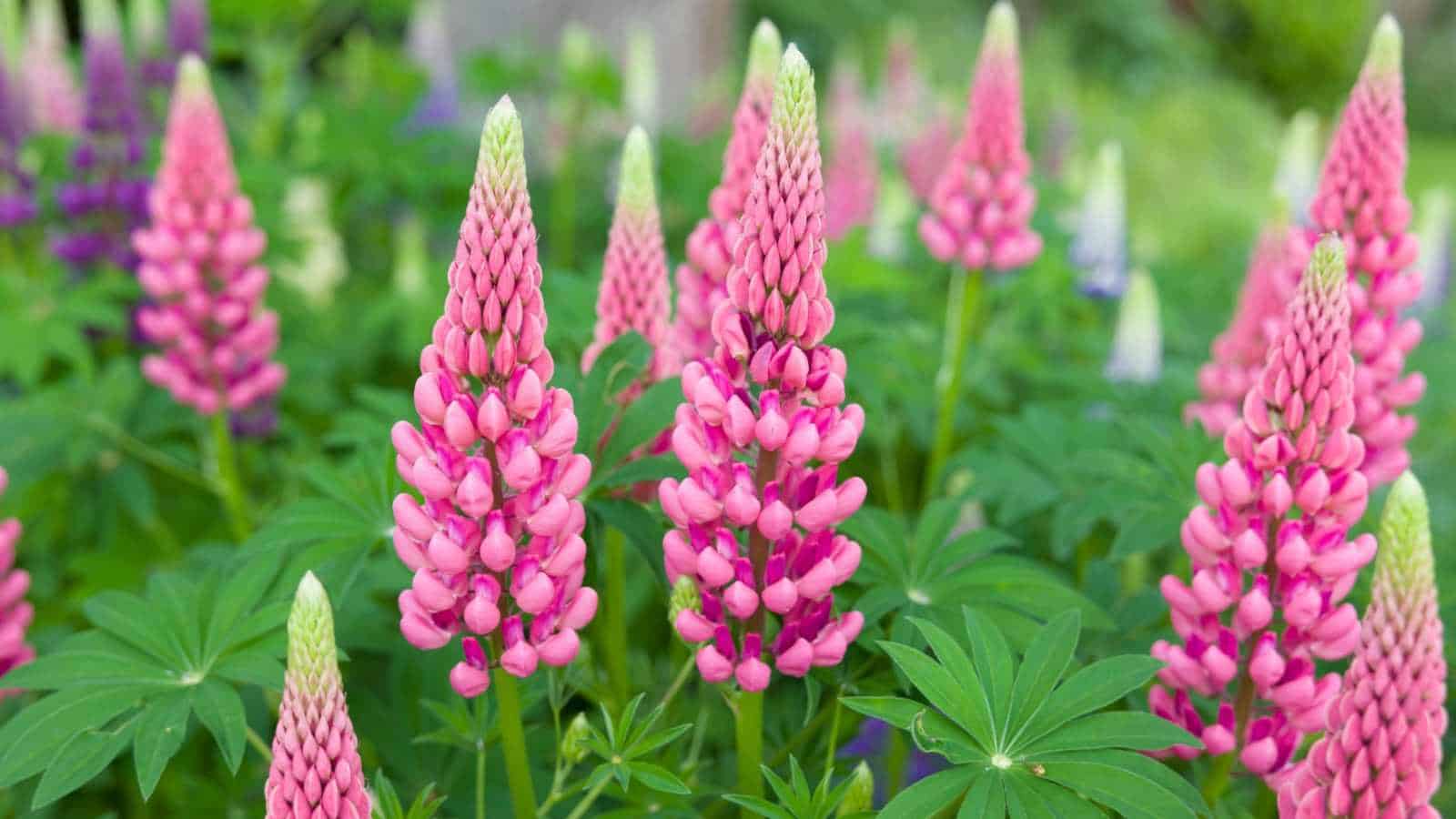
USDA hardiness zone: 4-8
Photo voltaic Publicity: Full Photo voltaic to Partial Shade
Soil Type: Successfully-drained, barely acidic to neutral
Lupines are a gaggle of perennial vegetation which could be recognized for his or her vibrant, towering flower spikes and attractive foliage. These spring flowers are an superior different for gardeners wanting in order so as to add high, coloration, and texture to their gardens.
What makes Lupines specific is their versatility and resilience. They will thrive in a variety of climates and soil conditions, making them an adaptable different for varied yard settings.
Their distinctive palm-shaped, inexperienced foliage offers a contact of magnificence to any yard, whereas their tall, vibrant flower spikes can attain as a lot as 4 toes in high, making a dramatic seen impression.
Any gardener must ponder rising Lupines not just for their magnificence, however moreover for his or her functionality to attract pollinators. These flowers are recognized to attract bees, hummingbirds, and butterflies, promoting biodiversity in your yard.
Lupines are low-maintenance vegetation, requiring minimal care as quickly as established. So, within the occasion you’re wanting in order so as to add a contact of drama and coloration to your yard, Lupines are a implausible different.
26. Sweet Alyssum
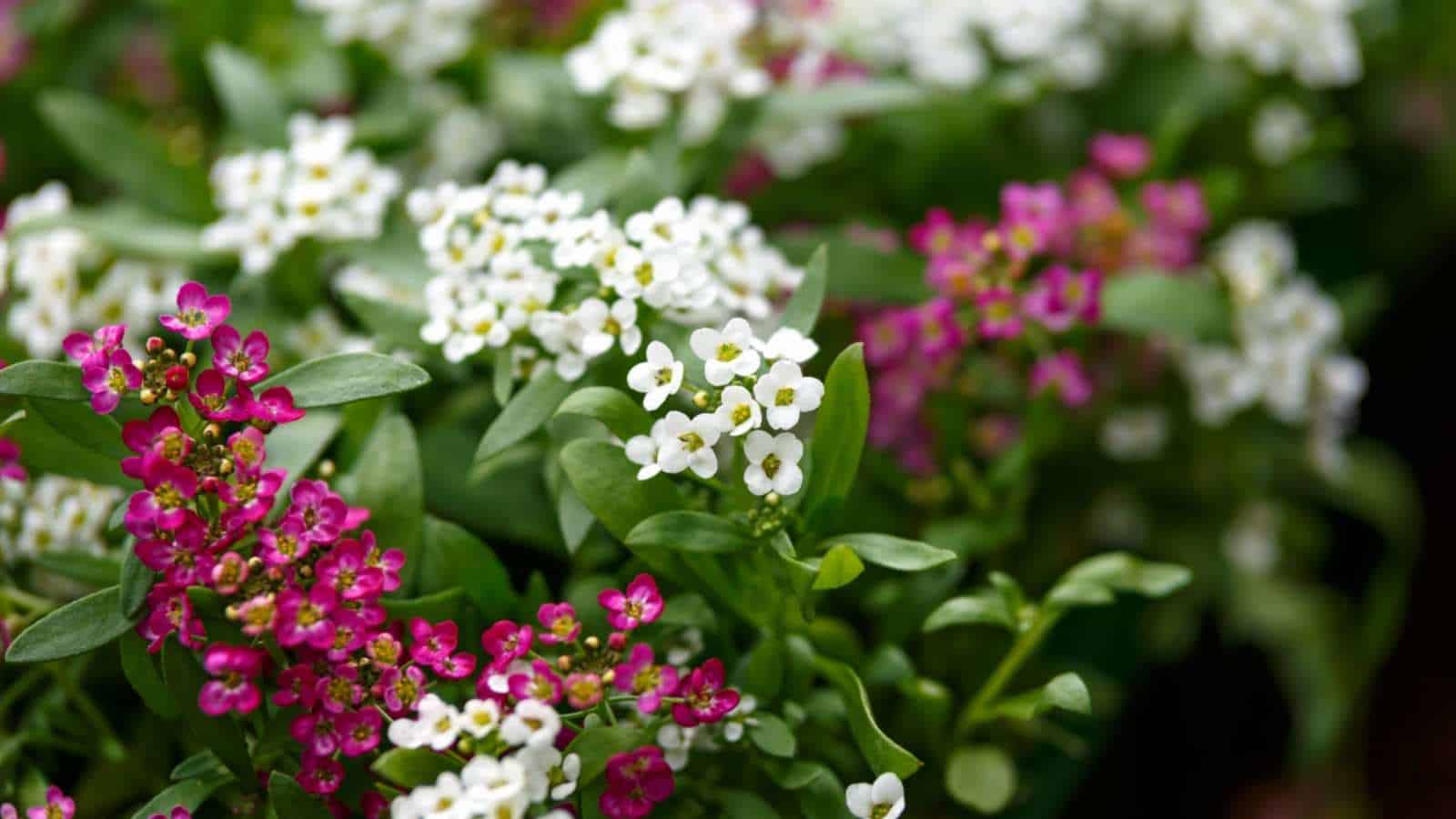
USDA hardiness zone: 7-10
Photo voltaic Publicity: Full photo voltaic to partial shade
Soil Type: Successfully-drained, fairly fertile
Sweet Alyssum, additionally known as Lobularia maritima, is a fascinating spring flower that is beloved by gardeners throughout the globe. This fragrant annual is a versatile addition to any yard, capable of thriving in a variety of conditions.
What makes Sweet Alyssum specific is its delicate, tiny blooms that cowl the plant in a carpet of white, pink, or purple.
The flowers have a refined, sweet scent that pulls helpful bugs akin to bees and butterflies, enhancing the overall biodiversity of your yard.
Any gardener must ponder rising Sweet Alyssum for its low repairs and extreme reward. It’s a hardy plant that will stand as much as cooler temperatures, making it an outstanding different for early spring planting.
Its spreading habits makes it an outstanding flooring cowl, filling in bare spots and providing a pretty, vibrant present. The Sweet Alyssum is an actual gem, bringing a part of attraction and magnificence to any yard setting.
27. Snapdragon
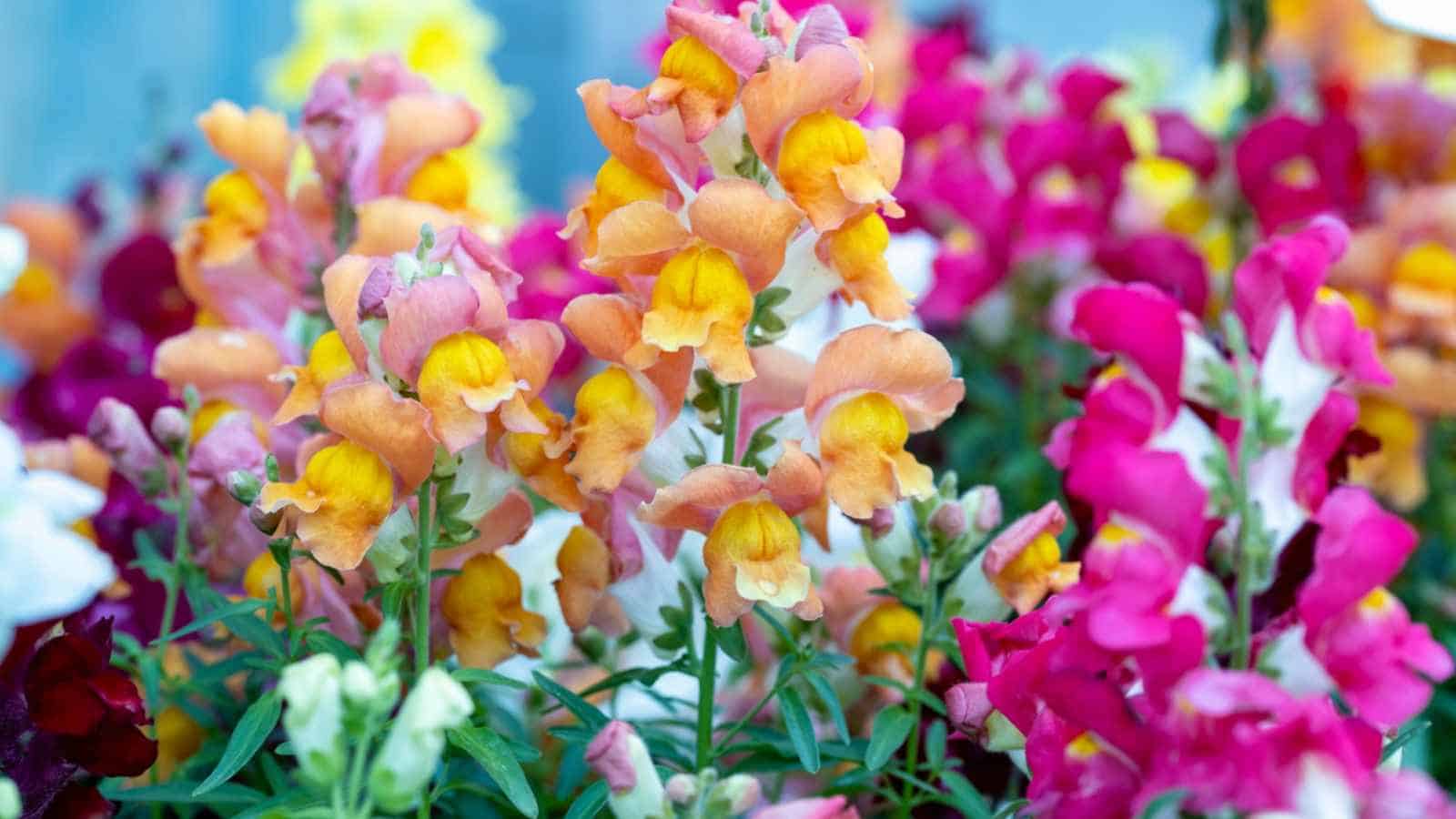
USDA Hardiness Zone: 7-10
Photo voltaic Publicity: Full Photo voltaic
Soil Type: Successfully-drained soil
Snapdragons are a conventional staple in any spring yard. Their vibrant colors and distinctive flower type make them stand out amongst totally different spring blooms.
They’re moreover recognized by their scientific establish, Antirrhinum, which apparently interprets to “like a snout”, referencing the peculiar type of the flower.
What makes Snapdragons specific is their versatility. They arrive in quite a lot of colors and sizes, from dwarf varieties which could be good for containers or borders, to towering giants that will attain as a lot as three toes tall. The flowers bloom upward alongside the stem, making a visually placing present.
Any gardener must ponder rising Snapdragons for his or her hardiness and low repairs requirements. They’re proof towards most pests and illnesses and may tolerate every cooler and warmer temperatures.
Snapdragons entice helpful bugs like bees and butterflies, promoting a healthful and vibrant yard. With their easy care and attention-grabbing magnificence, Snapdragons are an superior addition to any yard.
28. Allium
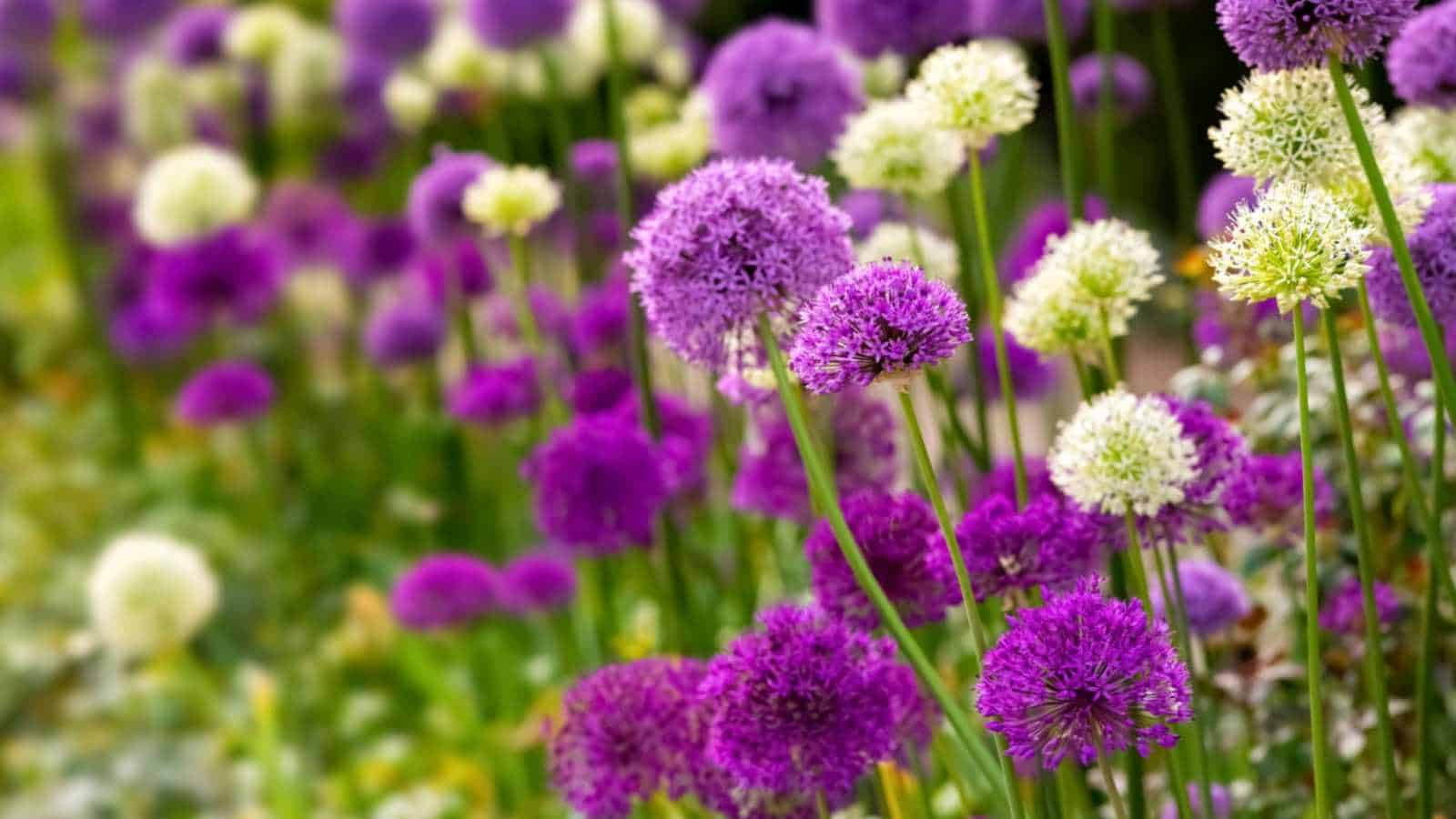
USDA Hardiness Zone: 4-9
Photo voltaic Publicity: Full Photo voltaic
Soil Type: Successfully-draining, sandy or loamy
The Allium, a vibrant spring flower, is a member of the onion family and boasts over 700 fully totally different species.
This varied genus comprises many vegetation we’re familiar with, akin to onions, garlic, chives, and leeks. Nevertheless it absolutely moreover includes a splendid array of ornamental yard vegetation.
What makes the Allium specific is its distinctive, spherical flower heads. They will fluctuate from petite and delicate to large and show-stopping. These blossoms sometimes appear to float above the rest of the yard, like whimsical, outsized lollipops.
Any gardener must ponder rising Alliums for his or her versatility and visual impression. They’re moreover remarkably hardy and proof towards pests and illnesses.
Their tall, sturdy stems and long-lasting blooms make them great for decrease flower preparations. With their easy care and dramatic presence, Alliums can add a contact of magic to any yard.
29. Sweet Pea
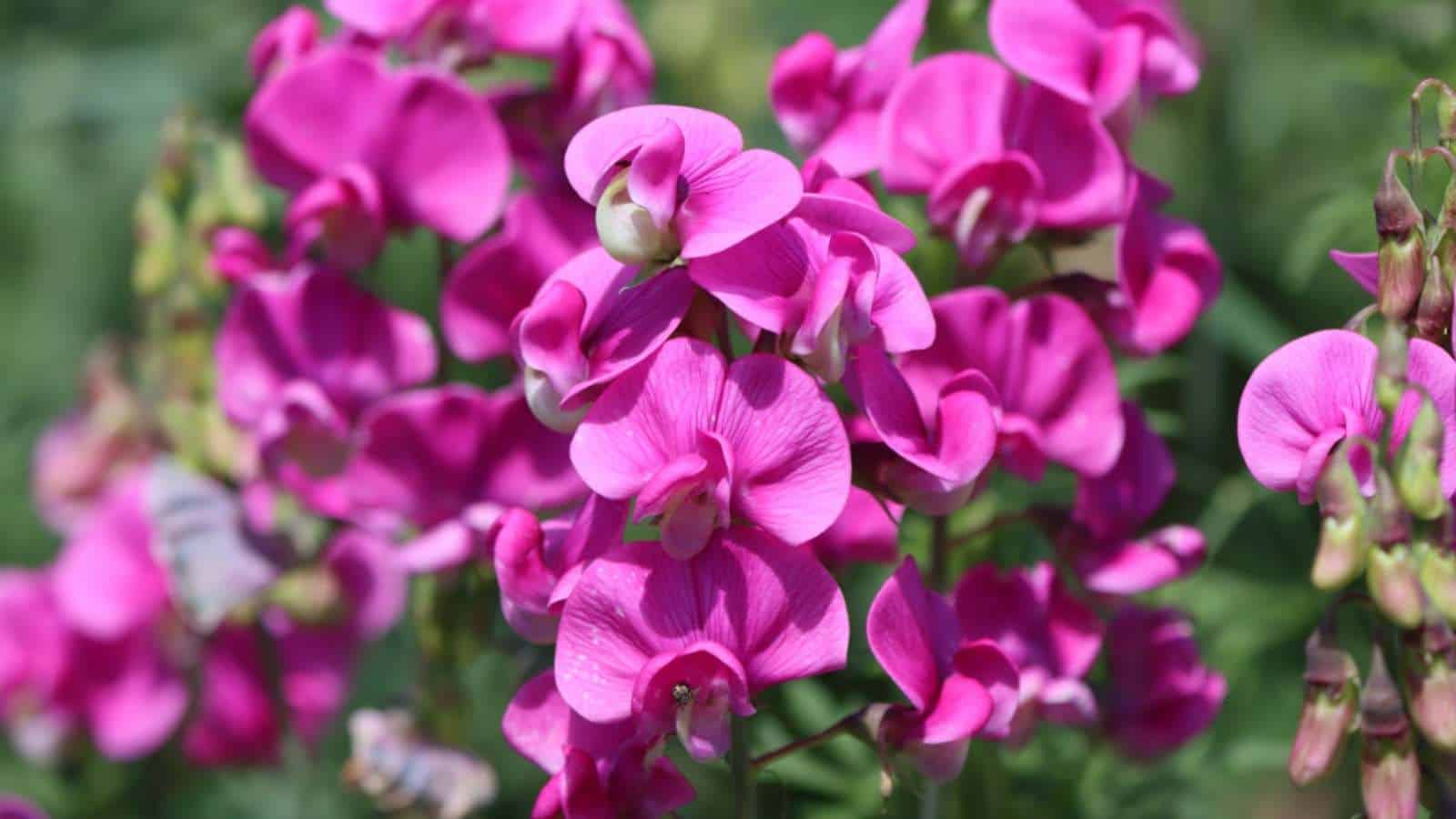
USDA hardiness zone: 7-10
Photo voltaic Publicity: Full Photo voltaic
Soil Type: Successfully-drained soil
The Sweet Pea, a fascinating and fragrant staple of the spring yard, is a beloved favorite amongst every novice and expert gardeners alike.
These annual climbing vegetation, with their delicate tendrils and vibrant blossoms, are a sight to behold in any yard setting.
What makes the Sweet Pea specific is its intoxicating fragrance and the variety of colors it boasts, from delicate pastels to vibrant hues. The flowers not solely add a pop of coloration however moreover a sweet, scent to your yard.
Any gardener must ponder rising Sweet Peas because of they’re comparatively easy to take care of and may add a vertical issue to your yard design.
Sweet Peas moreover entice pollinators, promoting biodiversity in your yard. Sweet Peas are good for decrease flowers, allowing you to convey a little bit of your yard and its enchanting aroma indoors.
30. Creeping Phlox
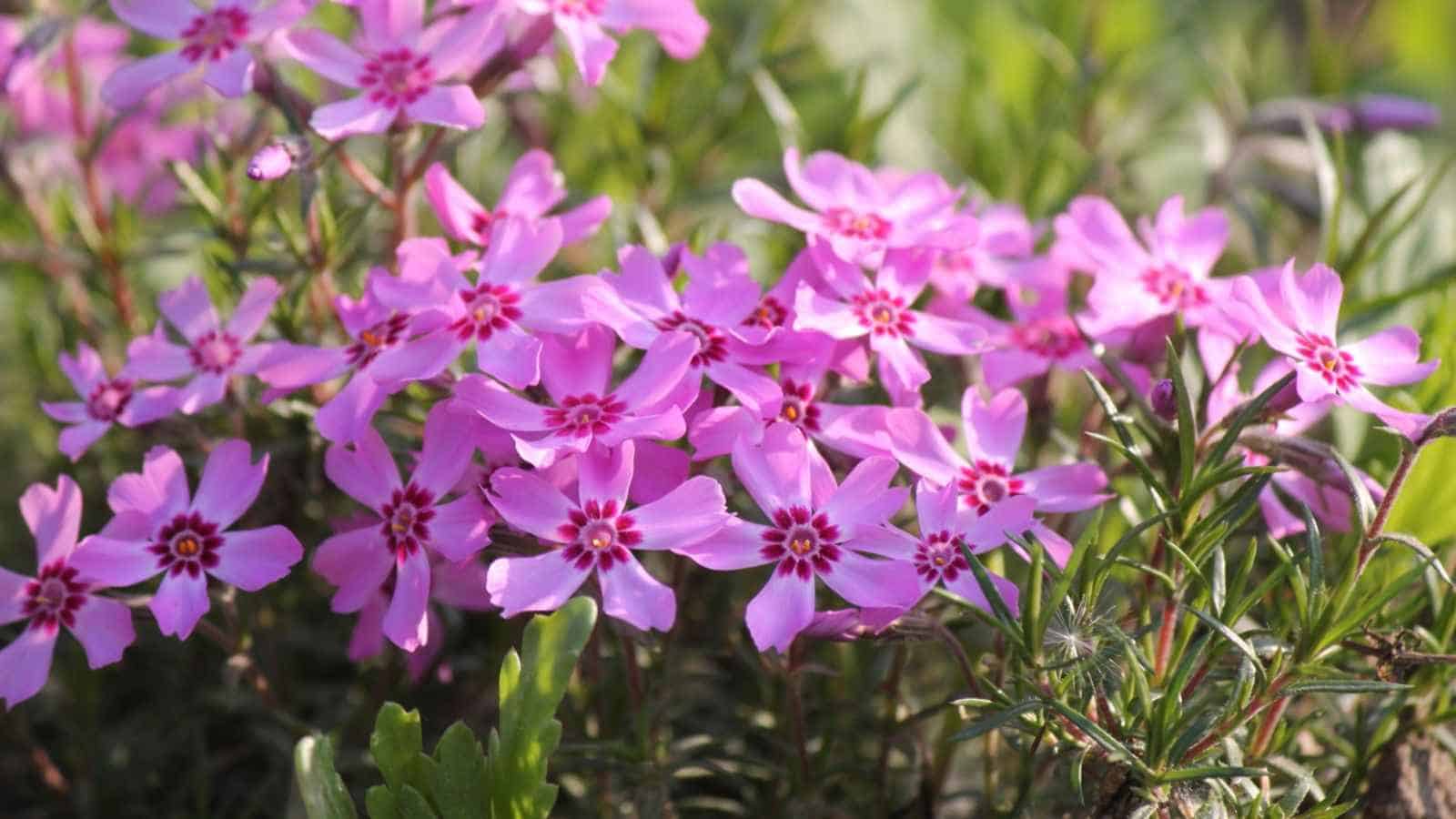
USDA hardiness zone: 3 – 9
Photo voltaic Publicity: Full Photo voltaic to Partial Shade
Soil Type: Successfully-drained, Sandy or Gravelly
Creeping Phlox, scientifically known as Phlox stolonifera, is a perennial flooring cowl cherished for its vibrant spring bloom. This plant, native to North America, is a herald of spring, with its carpet of coloration illuminating gardens as winter recedes.
What makes Creeping Phlox specific is its functionality to thrive in tough conditions. This hardy plant can survive in rocky or sandy soil, and as quickly as established, it requires minimal care.
Its mat-forming habits makes it an outstanding different for slopes and rock gardens, the place it could effectively forestall soil erosion whereas together with a contact of magnificence.
Every gardener must ponder rising Creeping Phlox not only for its aesthetic enchantment however moreover for its versatility. Its resistance to deer and drought, coupled with its functionality to attract butterflies, makes it a helpful addition to any yard.
31. Rhododendrons
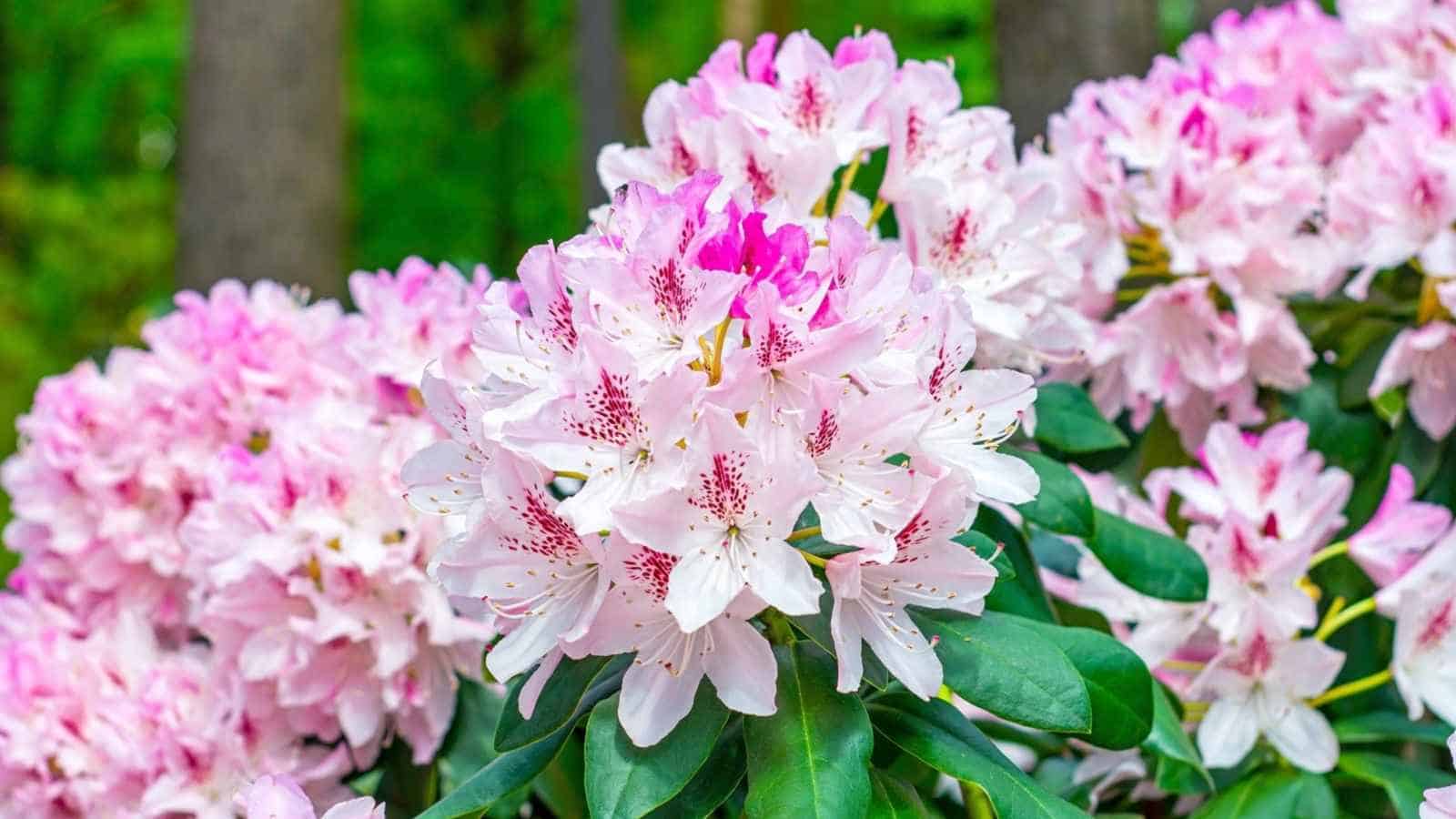
USDA hardiness zone: 4-8
Photo voltaic Publicity: Partial Shade
Soil Type: Successfully-Drained, Acidic
Rhododendrons are a varied group of flowering vegetation which could be a actual spectacle throughout the spring yard. Their vibrant blooms fluctuate from pink to purple, white, and even yellow, making them a versatile addition to any flower mattress.
What makes Rhododendrons specific is their functionality to create a stunning present of monumental, lush flowers that will ultimate for numerous weeks.
The shrubs themselves are evergreen, providing year-round curiosity with their darkish inexperienced leaves. In addition to, some varieties boast a lovely fragrance, together with but yet another dimension to their enchantment.
Any gardener must ponder rising Rhododendrons as a result of their low repairs needs and their adaptability to fully totally different gentle conditions.
These vegetation are moreover great for attracting pollinators akin to bees and butterflies, which might help to bolster the overall effectively being and beauty of your yard.
With their placing look and easy care, Rhododendrons are a implausible different for every novice and grasp gardeners alike.
32. Camellia
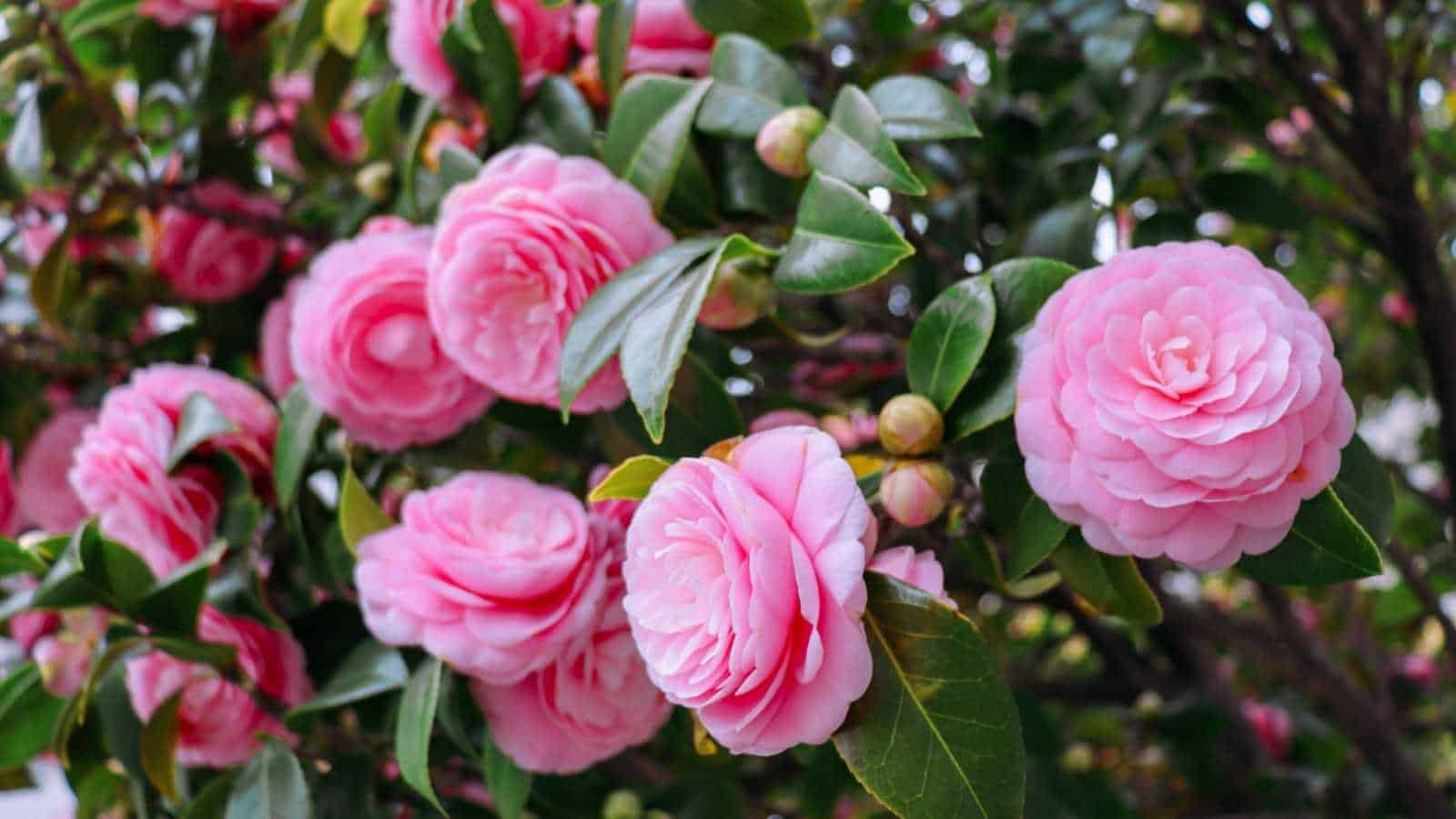
USDA hardiness zone: 6 – 10
Photo voltaic Publicity: Partial Shade
Soil Type: Successfully-drained, Acidic
Camellias are a gaggle of flowering vegetation native to jap and southern Asia. Acknowledged for his or her beautiful blooms and glossy evergreen leaves, they seem to be a favorite amongst gardeners and flower lovers alike.
What makes Camellia specific is its functionality to bloom throughout the cooler months, bringing coloration and life to a yard when most totally different vegetation have gentle.
These flowers can be found in a variety of colors along with pink, pink, and white, and some even have multicolored petals.
Any gardener must ponder rising Camellia not only for its magnificence however moreover for its hardiness. They’re comparatively low-maintenance vegetation that will thrive in quite a lot of conditions, making them acceptable for every novice and expert gardeners.
Their resistance to pests and illnesses extra offers to their enchantment. So, within the occasion you’re looking out for a plant that gives beautiful blooms, year-round foliage, and requires minimal care, Camellia must be in your itemizing.
Completely different Flower Guides from Planet Pure:
Easy to Develop Flowers: 10 Types of Flowers Anyone Can Develop
Sow and Develop: The 12 Greatest Flowers for Seed Starting
Secret Weapon Revealed: How Flowers Can Unlock the Hidden Potential of Your Veggie Yard
